Optical Fringe Projection: A Straightforward Approach to 3D Metrology
Abstract
1. Introduction
2. Fringe Projection Profilometry
- A bias term (background light);
- Fringe amplitude;
- A fringe phase map.
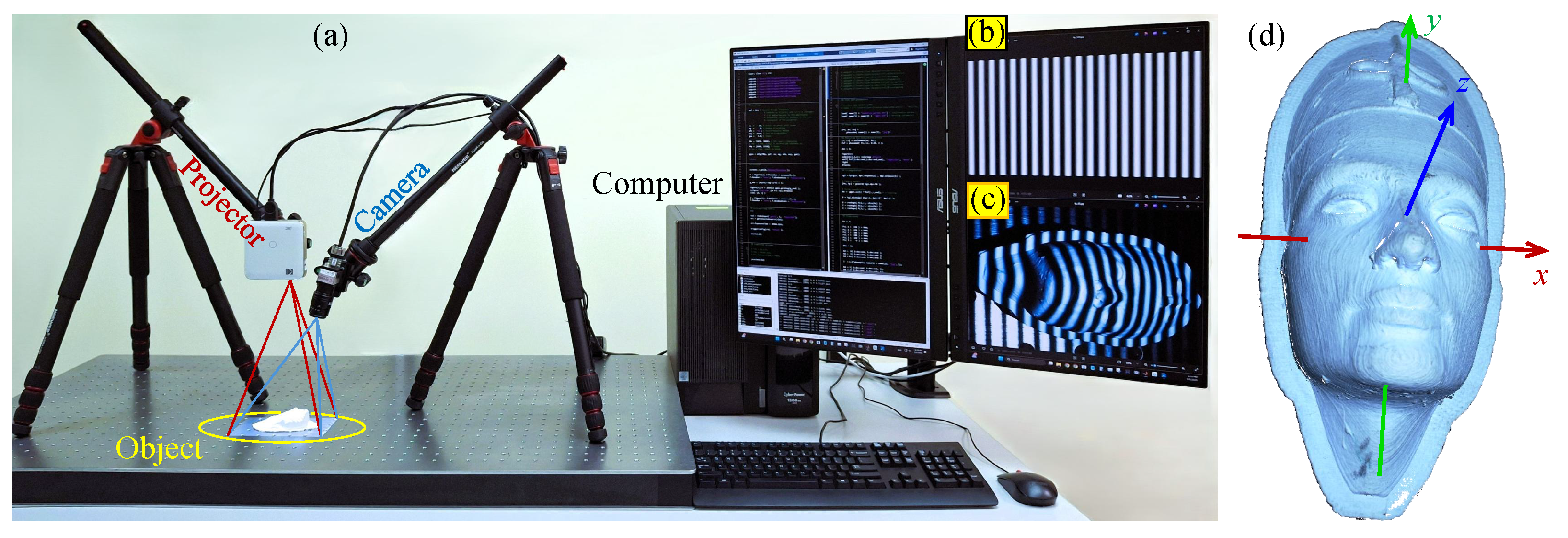
3. Fringe Projection System
3.1. Grating Generator
3.2. Wrapped Phase Extraction
3.2.1. Spatial Wrapped Phase Extraction and Fourier Fringe Analysis
3.2.2. Temporal Wrapped Phase Extraction (Phase-Shifting)
3.3. Phase Unwrapping
3.3.1. Spatial Phase Unwrapping
3.3.2. Temporal Phase Unwrapping and Multi-Frequency Approach
3.4. Phase-to-Coordinate Conversion
3.5. System Calibration
3.6. Miscellaneous
3.7. Hierarchical Multi-Frequency Phase-Shifting Fringe Projection
4. Theoretical Preliminaries
4.1. Camera Imaging
4.2. Cameras as Direction Sensors
4.3. Stereo Camera Systems and Triangulation
4.4. The Corresponding Point Problem
4.5. Equivalence Between Cameras and Projectors
4.6. Camera–Projector Systems
4.7. Structured Illumination
4.8. Fringe Projection
4.9. Phase and Object Profile Misconception
5. Phase-Demodulation Fringe-Pattern Processing
5.1. Phase-Shifting Wrapped Phase Extraction
5.2. Hierarchical Multi-Frequency Phase Unwrapping
5.3. Choosing Grating Frequencies
6. System Calibration
6.1. Camera Calibration
6.2. Projector Calibration
6.3. Camera–Projector Calibration
7. Optical 3D Metrology
8. Conclusions
Author Contributions
Funding
Institutional Review Board Statement
Informed Consent Statement
Conflicts of Interest
References
- Zhang, M.; Chen, C.; Xie, L.; Zhang, C. Accurate measurement of high-reflective surface based on adaptive fringe projection technique. Opt. Lasers Eng. 2024, 172, 107820. [Google Scholar] [CrossRef]
- Grambow, N.; Hinz, L.; Bonk, C.; Krüger, J.; Reithmeier, E. Creepage Distance Estimation of Hairpin Stators Using 3D Feature Extraction. Metrology 2023, 3, 169–185. [Google Scholar] [CrossRef]
- Chen, F.; Brown, G.M.; Song, M. Overview of 3-D shape measurement using optical methods. Opt. Eng. 2000, 39, 10–22. [Google Scholar]
- Zhang, S. (Ed.) Handbook of 3D Machine Vision: Optical Metrology and Imaging; Series in Optics and Optoelectronics; CRC Press: Boca Raton, FL, USA, 2013. [Google Scholar]
- Leach, R. (Ed.) Advances in Optical Form and Coordinate Metrology; Emerging Technologies in Optics and Photonics; IOP Publishing Ltd.: Bristol, UK, 2020. [Google Scholar]
- Wang, Z. Review of real-time three-dimensional shape measurement techniques. Measurement 2020, 156, 107624. [Google Scholar] [CrossRef]
- Zhang, Q.; Su, X. High-speed optical measurement for the drumhead vibration. Opt. Express 2005, 13, 3110–3116. [Google Scholar] [CrossRef]
- Su, X.; Zhang, Q. Dynamic 3-D shape measurement method: A review. Opt. Lasers Eng. 2010, 48, 191–204. [Google Scholar] [CrossRef]
- Zhang, S. High-speed 3D shape measurement with structured light methods: A review. Opt. Lasers Eng. 2018, 106, 119–131. [Google Scholar] [CrossRef]
- Chen, L.C.; Huang, C.C. Miniaturized 3D surface profilometer using digital fringe projection. Meas. Sci. Technol. 2005, 16, 1061. [Google Scholar] [CrossRef]
- Munkelt, C.; Schmidt, I.; Brauer-Burchardt, C.; Kuhmstedt, P.; Notni, G. Cordless portable multi-view fringe projection system for 3D reconstruction. In Proceedings of the IEEE Conference on Computer Vision and Pattern Recognition, Minneapolis, MN, USA, 17–22 June 2007; pp. 1–2. [Google Scholar]
- Zaman, T.; Jonker, P.; Lenseigne, B.; Dik, J. Simultaneous capture of the color and topography of paintings using fringe encoded stereo vision. Herit. Sci. 2014, 2, 23. [Google Scholar] [CrossRef]
- Liao, Y.H.; Hyun, J.S.; Feller, M.; Bell, T.; Bortins, I.; Wolfe, J.; Baldwin, D.; Zhang, S. Portable high-resolution automated 3D imaging for footwear and tire impression capture. J. Forensic Sci. 2021, 66, 112–128. [Google Scholar] [CrossRef]
- Kulkarni, R.; Rastogi, P. Optical measurement techniques—A push for digitization. Opt. Lasers Eng. 2016, 87, 1–17. [Google Scholar] [CrossRef]
- Xing, H.; She, S.; Wang, J.; Guo, J.; Liu, Q.; Wei, C.; Yang, L.; Peng, R.; Yue, H.; Liu, Y. High-frame rate, large-depth-range structured light projector based on the step-designed LED chips array. Opt. Express 2024, 32, 24117–24127. [Google Scholar] [CrossRef]
- Xu, J.; Zhang, S. Status, challenges, and future perspectives of fringe projection profilometry. Opt. Lasers Eng. 2020, 135, 106193. [Google Scholar] [CrossRef]
- Peng, R.; Zhou, G.; Zhang, C.; Wei, C.; Wang, X.; Chen, X.; Yang, L.; Yue, H.; Liu, Y. Ultra-small, low-cost, and simple-to-control PSP projector based on SLCD technology. Opt. Express 2024, 32, 1878–1889. [Google Scholar] [CrossRef] [PubMed]
- Chen, Z.; Li, X.; Wang, H.; Chen, Z.; Zhang, Q.; Wu, Z. Multi-dimensional information sensing of complex surfaces based on fringe projection profilometry. Opt. Express 2023, 31, 41374–41390. [Google Scholar] [CrossRef] [PubMed]
- Juarez-Salazar, R.; Benjumea, E.; Marrugo, A.G.; Diaz-Ramirez, V.H. Three-dimensional object texturing for visible-thermal fringe projection profilometers. In Proceedings of the Optics and Photonics for Information Processing XVIII, San Diego, CA, USA, 18–23 August 2024; Volume 13136, p. 131360E. [Google Scholar]
- Benjumea, E.; Vargas, R.; Juarez-Salazar, R.; Marrugo, A.G. Toward a target-free calibration of a multimodal structured light and thermal imaging system. In Proceedings of the Dimensional Optical Metrology and Inspection for Practical Applications XIII, National Harbor, MD, USA, 21–26 April 2024; Volume 13038, p. 1303808. [Google Scholar]
- Feng, S.; Zuo, C.; Zhang, L.; Tao, T.; Hu, Y.; Yin, W.; Qian, J.; Chen, Q. Calibration of fringe projection profilometry: A comparative review. Opt. Lasers Eng. 2021, 143, 106622. [Google Scholar] [CrossRef]
- Chen, R.; Xu, J.; Zhang, S.; Chen, H.; Guan, Y.; Chen, K. A self-recalibration method based on scale-invariant registration for structured light measurement systems. Opt. Lasers Eng. 2017, 88, 75–81. [Google Scholar] [CrossRef]
- Xiao, Y.L.; Xue, J.; Su, X. Robust self-calibration three-dimensional shape measurement in fringe-projection photogrammetry. Opt. Lett. 2013, 38, 694–696. [Google Scholar] [CrossRef]
- Wu, G.; Yang, T.; Liu, F.; Qian, K. Suppressing motion-induced phase error by using equal-step phase-shifting algorithms in fringe projection profilometry. Opt. Express 2022, 30, 17980–17998. [Google Scholar] [CrossRef]
- Jeon, S.; Geon Lee, H.; Sung Lee, J.; Min Kang, B.; Wook Jeon, B.; Young Yoon, J.; Hyun, J.S. Motion-Induced Error Reduction for Motorized Digital Fringe Projection System. IEEE Trans. Instrum. Meas. 2024, 73, 1–13. [Google Scholar] [CrossRef]
- Guo, W.; Wu, Z.; Zhang, Q.; Hou, Y.; Wang, Y.; Liu, Y. Generalized Phase Shift Deviation Estimation Method for Accurate 3-D Shape Measurement in Phase-Shifting Profilometry. IEEE Trans. Instrum. Meas. 2025, 74, 1–11. [Google Scholar] [CrossRef]
- He, Q.; Ning, J.; Liu, X.; Li, Q. Phase-shifting profilometry for 3D shape measurement of moving objects on production lines. Precis. Eng. 2025, 92, 30–38. [Google Scholar] [CrossRef]
- Juarez-Salazar, R. Flat mirrors, virtual rear-view cameras, and camera-mirror calibration. Optik 2024, 317, 172067. [Google Scholar] [CrossRef]
- Almaraz-Cabral, C.C.; Gonzalez-Barbosa, J.J.; Villa, J.; Hurtado-Ramos, J.B.; Ornelas-Rodriguez, F.J.; Córdova-Esparza, D.M. Fringe projection profilometry for panoramic 3D reconstruction. Opt. Lasers Eng. 2016, 78, 106–112. [Google Scholar] [CrossRef]
- Flores, V.; Casaletto, L.; Genovese, K.; Martinez, A.; Montes, A.; Rayas, J. A Panoramic Fringe Projection system. Opt. Lasers Eng. 2014, 58, 80–84. [Google Scholar] [CrossRef]
- Wang, Y.; Wu, X.; Hou, B.; Wang, B. Three-dimensional panoramic measurement based on fringe projection assisted by double-plane mirrors. Opt. Eng. 2024, 63, 114103. [Google Scholar] [CrossRef]
- Zhang, S.; Yang, Y.; Shi, W.; Feng, L.; Jiao, L. 3D shape measurement method for high-reflection surface based on fringe projection. Appl. Opt. 2021, 60, 10555–10563. [Google Scholar] [CrossRef]
- Feng, S.; Zhang, L.; Zuo, C.; Tao, T.; Chen, Q.; Gu, G. High dynamic range 3D measurements with fringe projection profilometry: A review. Meas. Sci. Technol. 2018, 29, 122001. [Google Scholar] [CrossRef]
- Zhang, S. Rapid and automatic optimal exposure control for digital fringe projection technique. Opt. Lasers Eng. 2020, 128, 106029. [Google Scholar] [CrossRef]
- Duan, M.; Jin, Y.; Chen, H.; Zheng, J.; Zhu, C.; Chen, E. Automatic 3-D Measurement Method for Nonuniform Moving Objects. IEEE Trans. Instrum. Meas. 2021, 70, 5015011. [Google Scholar] [CrossRef]
- Chen, R.; Xu, J.; Zhang, S. Digital fringe projection profilometry. In Advances in Optical Form and Coordinate Metrology; IOP Publishing: Bristol, UK, 2020; pp. 1–28. [Google Scholar]
- Zappa, E.; Busca, G. Static and dynamic features of Fourier transform profilometry: A review. Opt. Lasers Eng. 2012, 50, 1140–1151. [Google Scholar] [CrossRef]
- Keller, W.; Girard, J.; Goldberg, M.W.; Zhang, S. Precise calibration for error detection and correction in material extrusion additive manufacturing using digital fringe projection. Meas. Sci. Technol. 2025, 36, 025203. [Google Scholar] [CrossRef]
- Huang, H.; Niu, B.; Cheng, S.; Zhang, F. High-precision calibration and phase compensation method for structured light 3D imaging system. Opt. Lasers Eng. 2025, 186, 108788. [Google Scholar] [CrossRef]
- Yoshizawa, T. (Ed.) Handbook of Optical Metrology: Principles and Applications, 2nd ed.; CRC Press: Boca Raton, FL, USA, 2015. [Google Scholar]
- Rastogi, P.K. (Ed.) Digital Optical Measurement Techniques and Applications; Artech House Applied Photonics Series; Artech House: London, UK, 2015. [Google Scholar]
- Lv, S.; Tang, D.; Zhang, X.; Yang, D.; Deng, W.; Kemao, Q. Fringe projection profilometry method with high efficiency, precision, and convenience: Theoretical analysis and development. Opt. Express 2022, 30, 33515–33537. [Google Scholar] [CrossRef]
- Engel, T. 3D optical measurement techniques. Meas. Sci. Technol. 2023, 34, 032002. [Google Scholar] [CrossRef]
- Rowe, S.H.; Welford, W.T. Surface Topography of Non-optical Surfaces by Projected Interference Fringes. Nature 1967, 216, 786–787. [Google Scholar] [CrossRef]
- Wygant, R.W.; Almeida, S.P.; Soares, O.D.D. Surface inspection via projection interferometry. Appl. Opt. 1988, 27, 4626–4630. [Google Scholar] [CrossRef] [PubMed][Green Version]
- Ronchi, V. Forty Years of History of a Grating Interferometer. Appl. Opt. 1964, 3, 437–451. [Google Scholar] [CrossRef]
- Murty, M.V.R.K.; Shoemaker, A.H. Theory of Concentric Circular Grid. Appl. Opt. 1966, 5, 323–326. [Google Scholar] [CrossRef]
- Case, S.K.; Jalkio, J.A.; Kim, R.C. 3-D Vision System Analysis and Design. In Three-Dimensional Machine Vision; Kanade, T., Ed.; Springer: Boston, MA, USA, 1987; pp. 63–95. [Google Scholar]
- Malacara, D. (Ed.) Optical Shop Testing, 3rd ed.; John Wiley & Sons, Inc.: Hoboken, NJ, USA, 2007. [Google Scholar]
- Juarez-Salazar, R.; Robledo-Sanchez, C.; Guerrero-Sanchez, F.; Barcelata-Pinzon, A.; Gonzalez-Garcia, J.; Santiago-Alvarado, A. Intensity normalization of additive and multiplicative spatially multiplexed patterns with n encoded phases. Opt. Lasers Eng. 2016, 77, 225–229. [Google Scholar] [CrossRef]
- Juarez-Salazar, R.; Diaz-Ramirez, V.H. Estimation of amplitude and standard deviation of noisy sinusoidal signals. Opt. Eng. 2017, 56, 013109. [Google Scholar] [CrossRef]
- Servin, M.; Quiroga, J.A.; Padilla, M. Fringe Pattern Analysis for Optical Metrology: Theory, Algorithms, and Applications; Wiley: Hoboken, NJ, USA, 2014. [Google Scholar]
- Takasaki, H. Moiré Topography. Appl. Opt. 1970, 9, 1467–1472. [Google Scholar] [CrossRef]
- Meadows, D.M.; Johnson, W.O.; Allen, J.B. Generation of Surface Contours by Moiré Patterns. Appl. Opt. 1970, 9, 942–947. [Google Scholar] [CrossRef] [PubMed]
- Li, C.; Cao, Y.; Chen, C.; Wan, Y.; Fu, G.; Wang, Y. Computer-generated moiré profilometry. Opt. Express 2017, 25, 26815–26824. [Google Scholar] [CrossRef] [PubMed]
- Takasaki, H. Moiré Topography. Appl. Opt. 1973, 12, 845–850. [Google Scholar] [CrossRef]
- Takeda, M.; Mutoh, K. Fourier transform profilometry for the automatic measurement of 3-D object shapes. Appl. Opt. 1983, 22, 3977–3982. [Google Scholar] [CrossRef]
- Takeda, M.; Ina, H.; Kobayashi, S. Fourier-transform method of fringe-pattern analysis for computer-based topography and interferometry. J. Opt. Soc. Am. 1982, 72, 156–160. [Google Scholar] [CrossRef]
- Toyooka, S.; Iwaasa, Y. Automatic profilometry of 3-D diffuse objects by spatial phase detection. Appl. Opt. 1986, 25, 1630–1633. [Google Scholar] [CrossRef]
- Rodriguez-Vera, R.; Servin, M. Phase locked loop profilometry. Opt. Laser Technol. 1994, 26, 393–398. [Google Scholar] [CrossRef]
- Villa, J.; Servin, M.; Castillo, L. Profilometry for the measurement of 3-D object shapes based on regularized filters. Opt. Commun. 1999, 161, 13–18. [Google Scholar] [CrossRef]
- Sajan, M.R.; Tay, C.J.; Shang, H.M.; Asundi, A. Improved spatial phase detection for profilometry using a TDI imager. Opt. Commun. 1998, 150, 66–70. [Google Scholar] [CrossRef]
- Berryman, F.; Pynsent, P.; Cubillo, J. A theoretical comparison of three fringe analysis methods for determining the three-dimensional shape of an object in the presence of noise. Opt. Lasers Eng. 2003, 39, 35–50. [Google Scholar] [CrossRef]
- Srinivasan, V.; Liu, H.C.; Halioua, M. Automated phase-measuring profilometry of 3-D diffuse objects. Appl. Opt. 1984, 23, 3105–3108. [Google Scholar] [CrossRef] [PubMed]
- Reich, C.; Ritter, R.; Thesing, J. 3-D shape measurement of complex objects by combining photogrammetry and fringe projection. Opt. Eng. 2000, 39, 224–231. [Google Scholar] [CrossRef]
- Bruning, J.H.; Herriott, D.R.; Gallagher, J.E.; Rosenfeld, D.P.; White, A.D.; Brangaccio, D.J. Digital Wavefront Measuring Interferometer for Testing Optical Surfaces and Lenses. Appl. Opt. 1974, 13, 2693–2703. [Google Scholar] [CrossRef] [PubMed]
- Li, J.; Su, X.; Guo, L. Improved Fourier transform profilometry for the automatic measurement of three-dimensional object shapes. Opt. Eng. 1990, 29, 1439–1444. [Google Scholar]
- Juarez-Salazar, R.; Martinez-Laguna, J.; Diaz-Ramirez, V.H. Multi-demodulation phase-shifting and intensity pattern projection profilometry. Opt. Lasers Eng. 2020, 129, 106085. [Google Scholar] [CrossRef]
- Kemao, Q. Two-dimensional windowed Fourier transform for fringe pattern analysis: Principles, applications and implementations. Opt. Lasers Eng. 2007, 45, 304–317. [Google Scholar] [CrossRef]
- Casco-Vasquez, J.F.; Juarez-Salazar, R.; Robledo-Sanchez, C.; Rodriguez-Zurita, G.; Sanchez, F.G.; Arévalo Aguilar, L.M.; Meneses-Fabian, C. Fourier normalized-fringe analysis by zero-order spectrum suppression using a parameter estimation approach. Opt. Eng. 2013, 52, 074109. [Google Scholar] [CrossRef]
- Liu, Y.; Du, G.; Zhang, C.; Zhou, C.; Si, S.; Lei, Z. An improved two-step phase-shifting profilometry. Opt.—Int. J. Light Electron Opt. 2016, 127, 288–291. [Google Scholar] [CrossRef]
- Juarez-Salazar, R.; Robledo-Sanchez, C.; Meneses-Fabian, C.; Guerrero-Sanchez, F.; Aguilar, L.A. Generalized phase-shifting interferometry by parameter estimation with the least squares method. Opt. Lasers Eng. 2013, 51, 626–632. [Google Scholar] [CrossRef]
- Wei, Z.; Cao, Y.; Wu, H.; Xu, C.; Ruan, G.; Wu, F.; Li, C. Dynamic phase-differencing profilometry with number-theoretical phase unwrapping and interleaved projection. Opt. Express 2024, 32, 19578–19593. [Google Scholar] [CrossRef]
- Juarez-Salazar, R.; Guerrero-Sanchez, F.; Robledo-Sanchez, C. Theory and algorithms of an efficient fringe analysis technology for automatic measurement applications. Appl. Opt. 2015, 54, 5364–5374. [Google Scholar] [CrossRef]
- Su, X.; Su, L.; Li, W.; Xiang, L. New 3D profilometry based on modulation measurement. In Proceedings of the Automated Optical Inspection for Industry: Theory, Technology, and Applications II, Beijing, China, 16–19 September 1998; Ye, S., Ed.; SPIE: Bellingham, WA, USA, 1998; Volume 3558, pp. 1–7. [Google Scholar]
- Su, L.; Su, X.; Li, W.; Xiang, L. Application of modulation measurement profilometry to objects with surface holes. Appl. Opt. 1999, 38, 1153–1158. [Google Scholar] [CrossRef] [PubMed]
- Fang, Q.; Zheng, S. Linearly coded profilometry. Appl. Opt. 1997, 36, 2401–2407. [Google Scholar] [CrossRef] [PubMed]
- Geng, J. Structured-light 3D surface imaging: A tutorial. Adv. Opt. Photon. 2011, 3, 128–160. [Google Scholar] [CrossRef]
- Deng, J.; Li, J.; Feng, H.; Ding, S.; Xiao, Y.; Han, W.; Zeng, Z. Efficient intensity-based fringe projection profilometry method resistant to global illumination. Opt. Express 2020, 28, 36346–36360. [Google Scholar] [CrossRef]
- An, H.; Cao, Y.; Wu, H.; Yang, N.; Xu, C.; Li, H. Spatial-temporal phase unwrapping algorithm for fringe projection profilometry. Opt. Express 2021, 29, 20657–20672. [Google Scholar] [CrossRef]
- Marrugo, A.G.; Gao, F.; Zhang, S. State-of-the-art active optical techniques for three-dimensional surface metrology: A review [Invited]. J. Opt. Soc. Am. A 2020, 37, B60–B77. [Google Scholar] [CrossRef]
- Gorthi, S.S.; Rastogi, P.K. Fringe projection techniques: Whither we are? Opt. Lasers Eng. 2010, 48, 133–140. [Google Scholar] [CrossRef]
- Zuo, C.; Qian, J.; Feng, S.; Yin, W.; Li, Y.; Fan, P.; Han, J.; Qian, K.; Chen, Q. Deep learning in optical metrology: A review. Light. Sci. Appl. 2022, 11, 39. [Google Scholar] [CrossRef] [PubMed]
- Zhang, S. High-Speed 3D Imaging with Digital Fringe Projection Techniques; CRC Press: Boca Raton, FL, USA, 2016. [Google Scholar]
- Harding, K. (Ed.) Handbook of Optical Dimensional Metrology; Series in Optics and Optoelectronics; CRC Press: Boca Raton, FL, USA, 2013. [Google Scholar]
- Jiang, C.; Li, Y.; Feng, S.; Hu, Y.; Yin, W.; Qian, J.; Zuo, C.; Liang, J. Fringe Projection Profilometry. In Coded Optical Imaging; Springer International Publishing: Cham, Switzerland, 2024; Chapter 14; pp. 241–286. [Google Scholar]
- Yang, T.; Gu, F. Overview of modulation techniques for spatially structured-light 3D imaging. Opt. Laser Technol. 2024, 169, 110037. [Google Scholar] [CrossRef]
- Li, E.B.; Peng, X.; Xi, J.; Chicharo, J.F.; Yao, J.Q.; Zhang, D.W. Multi-frequency and multiple phase-shift sinusoidal fringe projection for 3D profilometry. Opt. Express 2005, 13, 1561–1569. [Google Scholar] [CrossRef] [PubMed]
- Wang, Y.; Zhang, S. Optimal fringe angle selection for digital fringe projection technique. Appl. Opt. 2013, 52, 7094–7098. [Google Scholar] [CrossRef] [PubMed]
- Geng, Z.J. Rainbow three-dimensional camera: New concept of high-speed three-dimensional vision systems. Opt. Eng. 1996, 35, 376–383. [Google Scholar] [CrossRef]
- Pan, J.; Huang, P.S.; Chiang, F.P. Color-coded binary fringe projection technique for 3-D shape measurement. Opt. Eng. 2005, 44, 023606. [Google Scholar] [CrossRef]
- Su, W.H. Color-encoded fringe projection for 3D shape measurements. Opt. Express 2007, 15, 13167–13181. [Google Scholar] [CrossRef]
- Waddington, C.; Kofman, J. Saturation avoidance by adaptive fringe projection in phase-shifting 3D surface-shape measurement. In Proceedings of the International Symposium on Optomechatronic Technologies, Toronto, ON, Canada, 25–27 October 2010; pp. 1–4. [Google Scholar]
- Salahieh, B.; Chen, Z.; Rodriguez, J.J.; Liang, R. Multi-polarization fringe projection imaging for high dynamic range objects. Opt. Express 2014, 22, 10064–10071. [Google Scholar] [CrossRef]
- Lagarde, J.M.; Rouvrais, C.; Black, D.; Diridollou, S.; Gall, Y. Skin topography measurement by interference fringe projection: A technical validation. Skin Res. Technol. 2001, 7, 112–121. [Google Scholar] [CrossRef]
- Wu, F.; Zhang, H.; Lalor, M.J.; Burton, D.R. A novel design for fiber optic interferometric fringe projection phase-shifting 3-D profilometry. Opt. Commun. 2001, 187, 347–357. [Google Scholar] [CrossRef]
- Sánchez, J.R.; Martínez-García, A.; Rayas, J.A.; León-Rodríguez, M. LED source interferometer for microscopic fringe projection profilometry using a Gates’ interferometer configuration. Opt. Lasers Eng. 2022, 149, 106822. [Google Scholar] [CrossRef]
- Schaffer, M.; Große, M.; Harendt, B.; Kowarschik, R. Coherent two-beam interference fringe projection for highspeed three-dimensional shape measurements. Appl. Opt. 2013, 52, 2306–2311. [Google Scholar] [CrossRef] [PubMed]
- Sicardi-Segade, A.; Martinez-Garcia, A.; Toto-Arellano, N.I.; Rayas, J.A. Analysis of the fringes visibility generated by a lateral cyclic shear interferometer in the retrieval of the three-dimensional surface information of an object. Opt.—Int. J. Light Electron Opt. 2014, 125, 1320–1324. [Google Scholar] [CrossRef]
- Robledo-Sanchez, C.; Juarez-Salazar, R.; Meneses-Fabian, C.; Guerrero-Sánchez, F.; Aguilar, L.M.A.; Rodriguez-Zurita, G.; Ixba-Santos, V. Phase-shifting interferometry based on the lateral displacement of the light source. Opt. Express 2013, 21, 17228–17233. [Google Scholar] [CrossRef] [PubMed]
- Creath, K.; Schmit, J.; Wyant, J.C. Optical metrology of diffuse surfaces. In Optical Shop Testing, 3rd ed.; Malacara, D., Ed.; John Wiley & Sons, Inc.: Hoboken, NJ, USA, 2007; pp. 756–807. [Google Scholar]
- Wang, L.; Cao, Y.; Li, C.; Wang, Y.; Wan, Y.; Fu, G.; Li, H.; Xu, C. Orthogonal modulated computer-generated moiré profilometry. Opt. Commun. 2020, 455, 124565. [Google Scholar] [CrossRef]
- Su, X.Y.; Zhou, W.S.; von Bally, G.; Vukicevic, D. Automated phase-measuring profilometry using defocused projection of a Ronchi grating. Opt. Commun. 1992, 94, 561–573. [Google Scholar] [CrossRef]
- Lei, S.; Zhang, S. Flexible 3-D shape measurement using projector defocusing. Opt. Lett. 2009, 34, 3080–3082. [Google Scholar] [CrossRef]
- Lei, S.; Zhang, S. Digital sinusoidal fringe pattern generation: Defocusing binary patterns VS focusing sinusoidal patterns. Opt. Lasers Eng. 2010, 48, 561–569. [Google Scholar] [CrossRef]
- Ayubi, G.A.; Ayubi, J.A.; Martino, J.M.D.; Ferrari, J.A. Pulse-width modulation in defocused three-dimensional fringe projection. Opt. Lett. 2010, 35, 3682–3684. [Google Scholar] [CrossRef]
- Silva, A.; Flores, J.L.; Muñoz, A.M.; Ayubi, G.A.; Ferrari, J.A. Three-dimensional shape profiling by out-of-focus projection of colored pulse width modulation fringe patterns. Appl. Opt. 2017, 56, 5198–5203. [Google Scholar] [CrossRef]
- Huang, P.S.; Hu, Q.; Jin, F.; Chiang, F.P. Color-encoded digital fringe projection technique for high-speed 3-D surface contouring. Opt. Eng. 1999, 38, 1065–1071. [Google Scholar] [CrossRef]
- Liu, W.; Wang, Z.; Mu, G.; Fang, Z. Color-coded projection grating method for shape measurement with a single exposure. Appl. Opt. 2000, 39, 3504–3508. [Google Scholar] [CrossRef] [PubMed]
- Wang, Y.; Zhang, S. Three-dimensional shape measurement with binary dithered patterns. Appl. Opt. 2012, 51, 6631–6636. [Google Scholar] [CrossRef] [PubMed]
- Peng, R.; Tian, M.; Xu, L.; Yang, L.; Yue, H. A novel method of generating phase-shifting sinusoidal fringes for 3D shape measurement. Opt. Lasers Eng. 2021, 137, 106401. [Google Scholar] [CrossRef]
- Fujigaki, M.; Oura, Y.; Asai, D.; Murata, Y. High-speed height measurement by a light-source-stepping method using a linear LED array. Opt. Express 2013, 21, 23169–23180. [Google Scholar] [CrossRef]
- Wissmann, P.; Forster, F.; Schmitt, R. Fast and low-cost structured light pattern sequence projection. Opt. Express 2011, 19, 24657–24671. [Google Scholar] [CrossRef]
- Heist, S.; Lutzke, P.; Schmidt, I.; Dietrich, P.; Kühmstedt, P.; Tünnermann, A.; Notni, G. High-speed three-dimensional shape measurement using GOBO projection. Opt. Lasers Eng. 2016, 87, 90–96. [Google Scholar] [CrossRef]
- Liu, Y.; Zhang, Q.; Liu, Y.; Yu, X.; Hou, Y.; Chen, W. High-speed 3D shape measurement using a rotary mechanical projector. Opt. Express 2021, 29, 7885–7903. [Google Scholar] [CrossRef]
- Huang, P.S.; Zhang, C.; Chiang, F.P. High-speed 3-D shape measurement based on digital fringe projection. Opt. Eng. 2003, 42, 163–168. [Google Scholar] [CrossRef]
- Zhu, Z.; You, D.; Zhou, F.; Wang, S.; Xie, Y. Rapid 3D reconstruction method based on the polarization-enhanced fringe pattern of an HDR object. Opt. Express 2021, 29, 2162–2171. [Google Scholar] [CrossRef]
- Zhu, H.; Guo, H. Surface profile measurement of metal objects by use of a fringe projection system with polarized dual projectors. Appl. Opt. 2024, 63, 7883–7892. [Google Scholar] [CrossRef]
- Zhang, S.; Weide, D.V.D.; Oliver, J. Superfast phase-shifting method for 3-D shape measurement. Opt. Express 2010, 18, 9684–9689. [Google Scholar] [CrossRef] [PubMed]
- Zendejas-Hernández, E.; Trujillo-Schiaffino, G.; Anguiano-Morales, M.; Salas-Peimbert, D.P.; Corral-Martínez, L.F.; Tornero-Martínez, N. Spatial and temporal methods for fringe pattern analysis: A review. J. Opt. 2023, 52, 888–899. [Google Scholar] [CrossRef]
- Zhang, Z. Review of single-shot 3D shape measurement by phase calculation-based fringe projection techniques. Opt. Lasers Eng. 2012, 50, 1097–1106. [Google Scholar] [CrossRef]
- Su, X.; Chen, W. Fourier transform profilometry: A review. Opt. Lasers Eng. 2001, 35, 263–284. [Google Scholar] [CrossRef]
- Takeda, M. Fourier fringe analysis and its application to metrology of extreme physical phenomena: A review [Invited]. Appl. Opt. 2013, 52, 20–29. [Google Scholar] [CrossRef]
- Sandoz, P. Wavelet transform as a processing tool in white-light interferometry. Opt. Lett. 1997, 22, 1065–1067. [Google Scholar] [CrossRef]
- Zhong, J.; Weng, J. Spatial carrier-fringe pattern analysis by means of wavelet transform: Wavelet transform profilometry. Appl. Opt. 2004, 43, 4993–4998. [Google Scholar] [CrossRef]
- Xu, P.; Liu, J.; Zhang, W.; Shan, S.; Wang, J.; Shao, M.; Deng, Z. Few-fringe-based phase-shifting profilometry employing hilbert transform. Precis. Eng. 2023, 83, 1–11. [Google Scholar] [CrossRef]
- Ferrari, J.A.; Flores, J.L.; Fernandez Lakatos, M.; Ayubi, G.A.; Perciante, C.D.; Frins, E. Hilbert’s and Takeda’s single-shot interferometry with a linear-carrier: A comparison. Meas. Sci. Technol. 2024, 35, 055006. [Google Scholar] [CrossRef]
- Jiang, M.; Chen, W.; Zheng, Z.; Zhong, M. Fringe pattern analysis by S-transform. Opt. Commun. 2012, 285, 209–217. [Google Scholar] [CrossRef]
- Massig, J.H.; Heppner, J. Fringe-Pattern Analysis with High Accuracy by Use of the Fourier-Transform Method: Theory and Experimental Tests. Appl. Opt. 2001, 40, 2081–2088. [Google Scholar] [CrossRef]
- Quan, C.; Chen, W.; Tay, C. Phase-retrieval techniques in fringe-projection profilometry. Opt. Lasers Eng. 2010, 48, 235–243. [Google Scholar] [CrossRef]
- Villa, J.; Luis Flores, J.; Garcia-Torales, G.; Montes-Flores, M. Fourier transform digital moiré interferometry. Meas. Sci. Technol. 2025, 36, 035208. [Google Scholar] [CrossRef]
- Zhang, Z.; Jing, Z.; Wang, Z.; Kuang, D. Comparison of Fourier transform, windowed Fourier transform, and wavelet transform methods for phase calculation at discontinuities in fringe projection profilometry. Opt. Lasers Eng. 2012, 50, 1152–1160. [Google Scholar] [CrossRef]
- Zuo, C.; Feng, S.; Huang, L.; Tao, T.; Yin, W.; Chen, Q. Phase shifting algorithms for fringe projection profilometry: A review. Opt. Lasers Eng. 2018, 109, 23–59. [Google Scholar] [CrossRef]
- Creath, K. V Phase-Measurement Interferometry Techniques. In Progress in Optics; Wolf, E., Ed.; Elsevier: Amsterdam, The Netherlands, 1988; Volume 26, pp. 349–393. [Google Scholar]
- Hariharan, P.; Oreb, B.F.; Eiju, T. Digital phase-shifting interferometry: A simple error-compensating phase calculation algorithm. Appl. Opt. 1987, 26, 2504–2506. [Google Scholar] [CrossRef] [PubMed]
- Malacara, D.; Servin, M.; Malacara, Z. Interferogram Analysis for Optical Testing, 2nd ed.; Taylor & Francis Group: Abingdon, UK, 2010. [Google Scholar]
- Carré, P. Installation et utilisation du comparateur photoélectrique et interférentiel du Bureau International des Poids et Mesures. Metrologia 1966, 2, 13. [Google Scholar] [CrossRef]
- Juarez-Salazar, R.; Robledo-Sanchez, C.; Guerrero-Sanchez, F.; Rangel-Huerta, A. Generalized phase-shifting algorithm for inhomogeneous phase shift and spatio-temporal fringe visibility variation. Opt. Express 2014, 22, 4738–4750. [Google Scholar] [CrossRef]
- Meneses-Fabian, C.; Lara-Cortes, F.A. Phase retrieval by Euclidean distance in self-calibrating generalized phase-shifting interferometry of three steps. Opt. Express 2015, 23, 13589–13604. [Google Scholar] [CrossRef]
- Greivenkamp, J.E. Generalized data reduction for heterodyne interferometry. Opt. Eng. 1984, 23, 234350–234352. [Google Scholar] [CrossRef]
- Morgan, C.J. Least-squares estimation in phase-measurement interferometry. Opt. Lett. 1982, 7, 368–370. [Google Scholar] [CrossRef] [PubMed]
- Ghiglia, D.C.; Pritt, M.D. Two-Dimensional Phase Unwrapping: Theory, Algorithms, and Software; John Wiley & Sons, Inc.: New York, NY, USA, 1998. [Google Scholar]
- Zappa, E.; Busca, G. Comparison of eight unwrapping algorithms applied to Fourier-transform profilometry. Opt. Lasers Eng. 2008, 46, 106–116. [Google Scholar] [CrossRef]
- Itoh, K. Analysis of the phase unwrapping algorithm. Appl. Opt. 1982, 21, 2470. [Google Scholar] [CrossRef]
- Ghiglia, D.C.; Romero, L.A. Robust two-dimensional weighted and unweighted phase unwrapping that uses fast transforms and iterative methods. J. Opt. Soc. Am. A 1994, 11, 107–117. [Google Scholar] [CrossRef]
- Schofield, M.A.; Zhu, Y. Fast phase unwrapping algorithm for interferometric applications. Opt. Lett. 2003, 28, 1194–1196. [Google Scholar] [CrossRef]
- Goldstein, R.M.; Zebker, H.A.; Werner, C.L. Satellite radar interferometry: Two-dimensional phase unwrapping. Radio Sci. 1988, 23, 713–720. [Google Scholar] [CrossRef]
- Flynn, T. Consistent 2-D phase unwrapping guided by a quality map. In Proceedings of the International Geoscience and Remote Sensing Symposium, Lincoln, NE, USA, 31 May 1996; Volume 4, pp. 2057–2059. [Google Scholar]
- Su, X.; Chen, W. Reliability-guided phase unwrapping algorithm: A review. Opt. Lasers Eng. 2004, 42, 245–261. [Google Scholar] [CrossRef]
- Zhao, M.; Huang, L.; Zhang, Q.; Su, X.; Asundi, A.; Kemao, Q. Quality-guided phase unwrapping technique: Comparison of quality maps and guiding strategies. Appl. Opt. 2011, 50, 6214–6224. [Google Scholar] [CrossRef]
- Ghiglia, D.C.; Romero, L.A. Minimum Lp-norm two-dimensional phase unwrapping. J. Opt. Soc. Am. A 1996, 13, 1999–2013. [Google Scholar] [CrossRef]
- Flynn, T.J. Two-dimensional phase unwrapping with minimum weighted discontinuity. J. Opt. Soc. Am. A 1997, 14, 2692–2701. [Google Scholar] [CrossRef]
- Costantini, M. A novel phase unwrapping method based on network programming. Geosci. Remote Sens. IEEE Trans. 1998, 36, 813–821. [Google Scholar] [CrossRef]
- Juarez-Salazar, R.; Robledo-Sanchez, C.; Guerrero-Sanchez, F. Phase-unwrapping algorithm by a rounding-least-squares approach. Opt. Eng. 2014, 53, 024102. [Google Scholar] [CrossRef]
- Sansoni, G.; Corini, S.; Lazzari, S.; Rodella, R.; Docchio, F. Three-dimensional imaging based on Gray-code light projection: Characterization of the measuring algorithm and development of a measuring system for industrial applications. Appl. Opt. 1997, 36, 4463–4472. [Google Scholar] [CrossRef] [PubMed]
- Sansoni, G.; Carocci, M.; Rodella, R. Three-Dimensional Vision Based on a Combination of Gray-Code and Phase-Shift Light Projection: Analysis and Compensation of the Systematic Errors. Appl. Opt. 1999, 38, 6565–6573. [Google Scholar] [CrossRef]
- Wu, Z.; Zuo, C.; Guo, W.; Tao, T.; Zhang, Q. High-speed three-dimensional shape measurement based on cyclic complementary Gray-code light. Opt. Express 2019, 27, 1283–1297. [Google Scholar] [CrossRef] [PubMed]
- He, X.; Zheng, D.; Kemao, Q.; Christopoulos, G. Quaternary gray-code phase unwrapping for binary fringe projection profilometry. Opt. Lasers Eng. 2019, 121, 358–368. [Google Scholar] [CrossRef]
- Tian, J.; Peng, X.; Zhao, X. A generalized temporal phase unwrapping algorithm for three-dimensional profilometry. Opt. Lasers Eng. 2008, 46, 336–342. [Google Scholar] [CrossRef]
- Zuo, C.; Huang, L.; Zhang, M.; Chen, Q.; Asundi, A. Temporal phase unwrapping algorithms for fringe projection profilometry: A comparative review. Opt. Lasers Eng. 2016, 85, 84–103. [Google Scholar] [CrossRef]
- Villa, J.; Rodríguez-Reveles, G.A.; Moreno, G.; de la Rosa, I. Temporal phase-unwrapping in fringe projection profilometry: Increasing the accuracy with equidistant long time-steps sampling. Opt. Lasers Eng. 2023, 167, 107591. [Google Scholar] [CrossRef]
- Zhang, S. Absolute phase retrieval methods for digital fringe projection profilometry: A review. Opt. Lasers Eng. 2018, 107, 28–37. [Google Scholar] [CrossRef]
- Wu, Z.; Guo, W.; Zhang, Q. Two-frequency phase-shifting method vs. Gray-coded-based method in dynamic fringe projection profilometry: A comparative review. Opt. Lasers Eng. 2022, 153, 106995. [Google Scholar] [CrossRef]
- Cheng, Y.Y.; Wyant, J.C. Two-wavelength phase shifting interferometry. Appl. Opt. 1984, 23, 4539–4543. [Google Scholar] [CrossRef] [PubMed]
- Towers, C.E.; Towers, D.P.; Jones, J.D.C. Generalized frequency selection in multifrequency interferometry. Opt. Lett. 2004, 29, 1348–1350. [Google Scholar] [CrossRef] [PubMed]
- Zhang, Z.; Towers, C.E.; Towers, D.P. Time efficient color fringe projection system for 3D shape and color using optimum 3-frequency Selection. Opt. Express 2006, 14, 6444–6455. [Google Scholar] [CrossRef] [PubMed]
- Huntley, J.M.; Saldner, H. Temporal phase-unwrapping algorithm for automated interferogram analysis. Appl. Opt. 1993, 32, 3047–3052. [Google Scholar] [CrossRef]
- Saldner, H.O.; Huntley, J.M. Temporal phase unwrapping: Application to surface profiling of discontinuous objects. Appl. Opt. 1997, 36, 2770–2775. [Google Scholar] [CrossRef]
- He, X.; Kemao, Q. A comparative study on temporal phase unwrapping methods in high-speed fringe projection profilometry. Opt. Lasers Eng. 2021, 142, 106613. [Google Scholar] [CrossRef]
- Zhang, M.; Chen, Q.; Tao, T.; Feng, S.; Hu, Y.; Li, H.; Zuo, C. Robust and efficient multi-frequency temporal phase unwrapping: Optimal fringe frequency and pattern sequence selection. Opt. Express 2017, 25, 20381–20400. [Google Scholar] [CrossRef]
- Su, X.; Song, W.; Cao, Y.; Xiang, L. Phase-height mapping and coordinate calibration simultaneously in phase-measuring profilometry. Opt. Eng. 2004, 43, 708–712. [Google Scholar]
- Zhou, W.S.; Su, X.Y. A Direct Mapping Algorithm for Phase-measuring Profilometry. J. Mod. Opt. 1994, 41, 89–94. [Google Scholar] [CrossRef]
- Zhang, J.; Luo, B.; Su, X.; Li, L.; Li, B.; Zhang, S.; Wang, Y. A convenient 3D reconstruction model based on parallel-axis structured light system. Opt. Lasers Eng. 2021, 138, 106366. [Google Scholar] [CrossRef]
- Liu, H.; Lin, H.; Yao, L. Calibration method for projector-camera-based telecentric fringe projection profilometry system. Opt. Express 2017, 25, 31492–31508. [Google Scholar] [CrossRef]
- Zhao, W.; Su, X.; Chen, W. Discussion on accurate phase-height mapping in fringe projection profilometry. Opt. Eng. 2017, 56, 104109. [Google Scholar] [CrossRef]
- Lu, J.; Mo, R.; Sun, H.; Chang, Z. Flexible calibration of phase-to-height conversion in fringe projection profilometry. Appl. Opt. 2016, 55, 6381–6388. [Google Scholar] [CrossRef] [PubMed]
- Xiao, Y.; Cao, Y.; Wu, Y. Improved algorithm for phase-to-height mapping in phase measuring profilometry. Appl. Opt. 2012, 51, 1149–1155. [Google Scholar] [CrossRef]
- Wang, Z.; Du, H.; Bi, H. Out-of-plane shape determination in generalized fringe projection profilometry. Opt. Express 2006, 14, 12122–12133. [Google Scholar] [CrossRef]
- Villa, J.; Araiza, M.; Alaniz, D.; Ivanov, R.; Ortiz, M. Transformation of phase to (x,y,z)-coordinates for the calibration of a fringe projection profilometer. Opt. Lasers Eng. 2012, 50, 256–261. [Google Scholar] [CrossRef]
- Cai, Z.; Liu, X.; Li, A.; Tang, Q.; Peng, X.; Gao, B.Z. Phase-3D mapping method developed from back-projection stereovision model for fringe projection profilometry. Opt. Express 2017, 25, 1262–1277. [Google Scholar] [CrossRef]
- Chen, L.; Quan, C. Fringe projection profilometry with nonparallel illumination: A least-squares approach. Opt. Lett. 2005, 30, 2101–2103. [Google Scholar] [CrossRef]
- Du, H.; Wang, Z. Three-dimensional shape measurement with an arbitrarily arranged fringe projection profilometry system. Opt. Lett. 2007, 32, 2438–2440. [Google Scholar] [CrossRef] [PubMed]
- Martinez, A.; Rayas, J.A.; Puga, H.J.; Genovese, K. Iterative estimation of the topography measurement by fringe-projection method with divergent illumination by considering the pitch variation along the x and z directions. Opt. Lasers Eng. 2010, 48, 877–881. [Google Scholar] [CrossRef]
- Huang, L.; Chua, P.S.K.; Asundi, A. Least-squares calibration method for fringe projection profilometry considering camera lens distortion. Appl. Opt. 2010, 49, 1539–1548. [Google Scholar] [CrossRef] [PubMed]
- Juarez-Salazar, R.; Diaz-Ramirez, V.H. Distorted pinhole camera model for tangential distortion. Proc. SPIE 2021, 11841, 118410D. [Google Scholar]
- Yang, S.; Liu, M.; Song, J.; Yin, S.; Ren, Y.; Zhu, J.; Chen, S. Projector distortion residual compensation in fringe projection system. Opt. Lasers Eng. 2019, 114, 104–110. [Google Scholar] [CrossRef]
- Juarez-Salazar, R.; Giron, A.; Zheng, J.; Diaz-Ramirez, V.H. Key concepts for phase-to-coordinate conversion in fringe projection systems. Appl. Opt. 2019, 58, 4828–4834. [Google Scholar] [CrossRef]
- Pei, X.; Liu, J.; Yang, Y.; Ren, M.; Zhu, L. Phase-to-Coordinates Calibration for Fringe Projection Profilometry Using Gaussian Process Regression. IEEE Trans. Instrum. Meas. 2022, 71, 5008112. [Google Scholar] [CrossRef]
- Li, J.; Ding, S.; Zeng, Z.; Deng, J. Dual-biprism-based coaxial fringe projection system. Appl. Opt. 2022, 61, 3957–3964. [Google Scholar] [CrossRef]
- Sicardi-Segade, A.; Estrada, J.; Martínez-García, A.; Garnica, G. On axis fringe projection: A new method for shape measurement. Opt. Lasers Eng. 2015, 69, 29–34. [Google Scholar] [CrossRef]
- Weng, W.; Chang, M.; Zeng, L.; Zhou, J.; Zhang, L.; Yu, X.; Liu, H. A novel and calibration-simple structured light 3D reconstruction system based on parallel-axis-display system. Opt. Commun. 2025, 579, 131580. [Google Scholar] [CrossRef]
- Li, D.; Liu, C.; Tian, J. Telecentric 3D profilometry based on phase-shifting fringe projection. Opt. Express 2014, 22, 31826–31835. [Google Scholar] [CrossRef] [PubMed]
- Hu, Y.; Chen, Q.; Feng, S.; Tao, T.; Asundi, A.; Zuo, C. A new microscopic telecentric stereo vision system—Calibration, rectification, and three-dimensional reconstruction. Opt. Lasers Eng. 2019, 113, 14–22. [Google Scholar] [CrossRef]
- Zhang, S.; Yau, S.T. High-resolution, real-time 3D absolute coordinate measurement based on a phase-shifting method. Opt. Express 2006, 14, 2644–2649. [Google Scholar] [CrossRef] [PubMed]
- Juarez-Salazar, R.; Rodriguez-Reveles, G.A.; Esquivel-Hernandez, S.; Diaz-Ramirez, V.H. Three-dimensional spatial point computation in fringe projection profilometry. Opt. Lasers Eng. 2023, 164, 107482. [Google Scholar] [CrossRef]
- Wang, Z.; Nguyen, D.A.; Barnes, J.C. Some practical considerations in fringe projection profilometry. Opt. Lasers Eng. 2010, 48, 218–225. [Google Scholar] [CrossRef]
- Yin, Y.; Peng, X.; Li, A.; Liu, X.; Gao, B.Z. Calibration of fringe projection profilometry with bundle adjustment strategy. Opt. Lett. 2012, 37, 542–544. [Google Scholar] [CrossRef]
- Rao, L.; Da, F.; Kong, W.; Huang, H. Flexible calibration method for telecentric fringe projection profilometry systems. Opt. Express 2016, 24, 1222–1237. [Google Scholar] [CrossRef]
- Zhang, S. Flexible and accurate phase-to-coordinate calibration method. In Proceedings of the Dimensional Optical Metrology and Inspection for Practical Applications XI, Orlando, FL, USA, 3 April–13 June 2022; Harding, K.G., Zhang, S., Hyun, J.S., Li, B., Eds.; SPIE: Bellingham, WA, USA, 2022; Volume 12098, p. 1209802. [Google Scholar]
- Bai, Y.; Zhang, Z.; Fu, S.; Zhao, H.; Ni, Y.; Gao, N.; Meng, Z.; Yang, Z.; Zhang, G.; Yin, W. Recent Progress of Full-Field Three-Dimensional Shape Measurement Based on Phase Information. Nanomanuf. Metrol. 2024, 7, 9. [Google Scholar] [CrossRef]
- Vargas, R.; Romero, L.A.; Zhang, S.; Marrugo, A.G. Calibration method based on virtual phase-to-coordinate mapping with linear correction function for structured light system. Opt. Lasers Eng. 2024, 183, 108496. [Google Scholar] [CrossRef]
- Moreno, D.; Taubin, G. Simple, Accurate, and Robust Projector-Camera Calibration. In Proceedings of the 2012 Second International Conference on 3D Imaging, Modeling, Processing, Visualization Transmission, Zurich, Switzerland, 13–15 October 2012; pp. 464–471. [Google Scholar]
- Li, Z.; Shi, Y.; Wang, C.; Wang, Y. Accurate calibration method for a structured light system. Opt. Eng. 2008, 47, 053604. [Google Scholar] [CrossRef]
- Yu, J.; Gao, N.; Meng, Z.; Zhang, Z. High-accuracy projector calibration method for fringe projection profilometry considering perspective transformation. Opt. Express 2021, 29, 15053–15066. [Google Scholar] [CrossRef] [PubMed]
- Salvi, J.; Fernandez, S.; Pribanic, T.; Llado, X. A state of the art in structured light patterns for surface profilometry. Pattern Recognit. 2010, 43, 2666–2680. [Google Scholar] [CrossRef]
- Legarda-Sáenz, R.; Bothe, T.; Jüptner, W.P. Accurate procedure for the calibration of a structured light system. Opt. Eng. 2004, 43, 464–471. [Google Scholar] [CrossRef]
- Kimura, M.; Mochimaru, M.; Kanade, T. Projector Calibration using Arbitrary Planes and Calibrated Camera. In Proceedings of the IEEE Conference on Computer Vision and Pattern Recognition, Minneapolis, MN, USA, 17–22 June 2007; pp. 1–2. [Google Scholar]
- Juarez-Salazar, R.; Diaz-Ramirez, V.H. Flexible camera-projector calibration using superposed color checkerboards. Opt. Lasers Eng. 2019, 120, 59–65. [Google Scholar] [CrossRef]
- Wang, J.; Zhang, Z.; Lu, W.; Jiang, X.J. High-Accuracy Calibration of High-Speed Fringe Projection Profilometry Using a Checkerboard. IEEE/ASME Trans. Mechatronics 2022, 27, 4199–4204. [Google Scholar] [CrossRef]
- Zhang, S.; Huang, P.S. Novel method for structured light system calibration. Opt. Eng. 2006, 45, 083601. [Google Scholar] [CrossRef]
- Zhang, C.; Zhu, D.; Shi, W.; Wang, L.; Li, J. Improved calibration and 3D reconstruction for micro fringe projection profilometry. Opt. Express 2025, 33, 13455–13471. [Google Scholar] [CrossRef]
- Huang, B.; Tang, Y.; Ozdemir, S.; Ling, H. A Fast and Flexible Projector-Camera Calibration System. IEEE Trans. Autom. Sci. Eng. 2021, 18, 1049–1063. [Google Scholar] [CrossRef]
- Schreiber, W.; Notni, G. Theory and arrangements of self-calibrating whole-body 3-D-measurement systems using fringe projection technique. Opt. Eng. 2000, 39, 159–169. [Google Scholar] [CrossRef]
- Juarez-Salazar, R.; Diaz-Ramirez, V.H.; Robledo-Sanchez, C.; Diaz-Gonzalez, G. On the use of video projectors for three-dimensional scanning. Proc. SPIE 2017, 10395, 103950C. [Google Scholar]
- Jiang, C.; Xing, S.; Guo, H. Fringe harmonics elimination in multi-frequency phase-shifting fringe projection profilometry. Opt. Express 2020, 28, 2838–2856. [Google Scholar] [CrossRef]
- Sun, X.; Zhang, Y.; Kong, L.; Peng, X.; Luo, Z.; Shi, J.; Tian, L. Multi-Color Channel Gamma Correction in Fringe Projection Profilometry. Photonics 2025, 12, 74. [Google Scholar] [CrossRef]
- Poynton, C.A. “Gamma” and its Disguises: The Nonlinear Mappings of Intensity in Perception, CRTs, Film, and Video. SMPTE J. 1993, 102, 1099–1108. [Google Scholar] [CrossRef]
- Ayubi, G.A.; Martino, J.M.D.; Alonso, J.R.; Fernández, A.; Perciante, C.D.; Ferrari, J.A. Three-dimensional profiling with binary fringes using phase-shifting interferometry algorithms. Appl. Opt. 2011, 50, 147–154. [Google Scholar] [CrossRef] [PubMed]
- Son, S.J.; An, Y.; Hyun, J.S. Fringe projection profilometry using model-free distorted patterns. Opt. Express 2025, 33, 17527–17543. [Google Scholar] [CrossRef]
- Guo, H.; He, H.; Chen, M. Gamma correction for digital fringe projection profilometry. Appl. Opt. 2004, 43, 2906–2914. [Google Scholar] [CrossRef]
- Liu, K.; Wang, Y.; Lau, D.L.; Hao, Q.; Hassebrook, L.G. Gamma model and its analysis for phase measuring profilometry. J. Opt. Soc. Am. A 2010, 27, 553–562. [Google Scholar] [CrossRef] [PubMed]
- Zhang, X.; Zhu, L.; Li, Y.; Tu, D. Generic nonsinusoidal fringe model and gamma calibration in phase measuring profilometry. J. Opt. Soc. Am. A 2012, 29, 1047–1058. [Google Scholar] [CrossRef]
- Wang, Y.; Cai, J.; Zhang, D.; Chen, X.; Wang, Y. Nonlinear Correction for Fringe Projection Profilometry with Shifted-Phase Histogram Equalization. IEEE Trans. Instrum. Meas. 2022, 71, 5005509. [Google Scholar] [CrossRef]
- Hoang, T.; Pan, B.; Nguyen, D.; Wang, Z. Generic gamma correction for accuracy enhancement in fringe-projection profilometry. Opt. Lett. 2010, 35, 1992–1994. [Google Scholar] [CrossRef]
- Yatabe, K.; Ishikawa, K.; Oikawa, Y. Compensation of fringe distortion for phase-shifting three-dimensional shape measurement by inverse map estimation. Appl. Opt. 2016, 55, 6017–6024. [Google Scholar] [CrossRef] [PubMed]
- Yu, X.; Liu, Y.; Liu, N.; Fan, M.; Su, X. Flexible gamma calculation algorithm based on probability distribution function in digital fringe projection system. Opt. Express 2019, 27, 32047–32057. [Google Scholar] [CrossRef] [PubMed]
- García-Isáis, C.A.; Ochoa, N.A.; Cruz-Salgado, J. Simultaneous one-shot profilometry and gamma correction. Opt. Eng. 2019, 58, 034104. [Google Scholar] [CrossRef]
- Munoz, A.; Flores, J.L.; Parra-Escamilla, G.; Morales, L.A.; Ordones, S.; Servin, M. Least-squares gamma estimation in fringe projection profilometry. Appl. Opt. 2021, 60, 1137–1142. [Google Scholar] [CrossRef]
- Li, L.; Xu, X.; Pang, J.; Wu, J. Study on gamma correction for three-dimensional fringe projection measurement based on attention U-Net network. Opt. Eng. 2024, 63, 053103. [Google Scholar] [CrossRef]
- Zhang, S. Comparative study on passive and active projector nonlinear gamma calibration. Appl. Opt. 2015, 54, 3834–3841. [Google Scholar] [CrossRef]
- Gai, S.; Da, F. A novel fringe adaptation method for digital projector. Opt. Lasers Eng. 2011, 49, 547–552. [Google Scholar] [CrossRef]
- Yuan, L.; Kang, J.; Feng, L.; Chen, Y.; Wu, B. Accurate calibration for crosstalk coefficient based on orthogonal color phase-shifting pattern. Opt. Express 2023, 31, 23115–23126. [Google Scholar] [CrossRef]
- Zhu, Q.; Zhao, H.; Zhao, Z. Research on iterative decoupling algorithm in color fringe projection profilometry. Opt. Laser Technol. 2023, 164, 109541. [Google Scholar] [CrossRef]
- Huang, P.S.; Hu, Q.; Jin, F.; Chiang, F.P. Color-encoded fringe projection and phase shifting for 3D surface contouring. Proc. SPIE 1998, 3407, 477–482. [Google Scholar]
- Hu, J.; Mai, S.; Jiang, Y.; Xu, Y. A high-precision crosstalk coefficient calibration method based on maximum distance rotating fringes and noise suppression by spatial matching filtering. Opt. Laser Technol. 2025, 183, 112301. [Google Scholar] [CrossRef]
- Liu, B.; Wang, C.; Wang, S.; Wu, G. Color crosstalk compensation method for color phase-shifting fringe projection profilometry based on the phase correction matrix. Opt. Express 2024, 32, 5793–5808. [Google Scholar] [CrossRef] [PubMed]
- Zhu, L.; Cao, Y.; He, D.; Chen, C. Grayscale imbalance correction in real-time phase measuring profilometry. Opt. Commun. 2016, 376, 72–80. [Google Scholar] [CrossRef]
- Pan, J.; Huang, P.S.; Chiang, F.P. Color-encoded digital fringe projection technique for high-speed 3-D shape measurement: Color coupling and imbalance compensation. In Proceedings of the Two- and Three-Dimensional Vision Systems for Inspection, Control, and Metrology, Philadelphia, PA, USA, 25–28 October 2004; Batchelor, B.G., Hugli, H., Eds.; Volume 5265, pp. 205–212. [Google Scholar]
- Zhao, X.; Yu, T.; Liang, D.; He, Z. A review on 3D measurement of highly reflective objects using structured light projection. Int. J. Adv. Manuf. Technol. 2024, 132, 4205–4222. [Google Scholar] [CrossRef]
- Juarez-Salazar, R.; Vega, F.; Esquivel-Hernandez, S.; Diaz-Ramirez, V.H.; Marrugo, A.G. Phase feedback fringe projection profilometry for shiny objects. Opt. Lasers Eng. 2025, 191, 109013. [Google Scholar] [CrossRef]
- Feng, L.; Sun, Z.; Chen, Y.; Li, H.; Chen, Y.; Liu, H.; Liu, R.; Zhao, Z.; Liang, J.; Zhang, Z.; et al. Rapid in-situ accuracy evaluation and exposure optimization method for fringe projection profilometry. Opt. Laser Technol. 2025, 181, 111844. [Google Scholar] [CrossRef]
- Zhang, S. Recent progresses on real-time 3D shape measurement using digital fringe projection techniques. Opt. Lasers Eng. 2010, 48, 149–158. [Google Scholar] [CrossRef]
- Yin, W.; Chen, Q.; Feng, S.; Tao, T.; Huang, L.; Trusiak, M.; Asundi, A.; Zuo, C. Temporal phase unwrapping using deep learning. Sci. Rep. 2019, 9, 20175. [Google Scholar] [CrossRef]
- Wang, K.; Kemao, Q.; Di, J.; Zhao, J. Deep learning spatial phase unwrapping: A comparative review. Adv. Photonics Nexus 2022, 1, 014001. [Google Scholar] [CrossRef]
- Lv, S.; Kemao, Q. Modeling the measurement precision of Fringe Projection Profilometry. Light. Sci. Appl. 2023, 12, 257. [Google Scholar] [CrossRef]
- Shang, H.; Liu, C.; Wang, R. Measurement methods of 3D shape of large-scale complex surfaces based on computer vision: A review. Measurement 2022, 197, 111302. [Google Scholar] [CrossRef]
- An, H.; Cao, Y.; Li, H.; Zhang, H. Temporal Phase Unwrapping Based on Unequal Phase-Shifting Code. IEEE Trans. Image Process. 2023, 32, 1432–1441. [Google Scholar] [CrossRef] [PubMed]
- Wu, H.; Cao, Y.; Dai, Y.; Qin, J. Spatial-Temporal 3-D Directional Binary Coding Method for Fringe Projection Profilometry. IEEE Trans. Instrum. Meas. 2025, 74, 1009211. [Google Scholar] [CrossRef]
- Ray, S. Applied Photographic Optics, 3rd ed.; Taylor & Francis: Abingdon, UK, 2002. [Google Scholar]
- Hartley, R.; Zisserman, A. Multiple View Geometry in Computer Vision, 2nd ed.; Cambridge University Press: Cambridge, UK, 2003. [Google Scholar]
- Juarez-Salazar, R.; Zheng, J.; Diaz-Ramirez, V.H. Distorted pinhole camera modeling and calibration. Appl. Opt. 2020, 59, 11310–11318. [Google Scholar] [CrossRef]
- Juarez-Salazar, R.; Diaz-Ramirez, V.H. Operator-based homogeneous coordinates: Application in camera document scanning. Opt. Eng. 2017, 56, 070801. [Google Scholar] [CrossRef][Green Version]
- Maciel, J.; Costeira, J. A global solution to sparse correspondence problems. IEEE Trans. Pattern Anal. Mach. Intell. 2003, 25, 187–199. [Google Scholar] [CrossRef]
- Mouaddib, E.; Batlle, J.; Salvi, J. Recent progress in structured light in order to solve the correspondence problem in stereovision. In Proceedings of the International Conference on Robotics and Automation, Albuquerque, NM, USA, 25 April 1997; Volume 1, pp. 130–136. [Google Scholar]
- Juarez-Salazar, R.; Rios-Orellana, O.I.; Diaz-Ramirez, V.H. Stereo-phase rectification for metric profilometry with two calibrated cameras and one uncalibrated projector. Appl. Opt. 2022, 61, 6097–6109. [Google Scholar] [CrossRef]
- Rastogi, P.; Hack, E. Phase Estimation in Optical Interferometry; Taylor & Francis: Abingdon, UK, 2014. [Google Scholar]
- Juarez-Salazar, R.; Mendoza-Rodriguez, C.; Hernandez-Beltran, J.E.; Robledo-Sanchez, C. How do phase-shifting algorithms work? Eur. J. Phys. 2018, 39, 065302. [Google Scholar] [CrossRef]
- Zhang, Z. A flexible new technique for camera calibration. IEEE Trans. Pattern Anal. Mach. Intell. 2000, 22, 1330–1334. [Google Scholar] [CrossRef]
- Juarez-Salazar, R.; Esquivel-Hernandez, S.; Diaz-Ramirez, V.H. Are camera, projector, and camera-projector calibrations different? Appl. Opt. 2023, 62, 5999–6006. [Google Scholar] [CrossRef]
- Geiger, A.; Moosmann, F.; Car, O.; Schuster, B. Automatic camera and range sensor calibration using a single shot. In Proceedings of the IEEE International Conference on Robotics and Automation, Saint Paul, MN, USA, 14–18 May 2012; pp. 3936–3943. [Google Scholar]
- Juarez-Salazar, R.; Zheng, J.; Giron, A.; Diaz-Ramirez, V.H. Calibration of camera-projector fringe projection systems for three-dimensional scanning. Proc. SPIE 2019, 11136, 111360D. [Google Scholar]
- Xu, L.; Cao, Y.; Yu, Y.; Wang, J.; Zhou, L. Projector undistortion for high-accuracy fringe projection profilometry. Meas. Sci. Technol. 2021, 32, 105009. [Google Scholar] [CrossRef]
- Liu, S.; Zhang, G.; Lau, D.L.; Zhang, B.; Xu, B.; Liu, K. Jointly correcting lens distortion of structured light systems. J. Opt. 2024, 27, 015702. [Google Scholar] [CrossRef]
- Rivera-Ortega, U.; Dirckx, J.; Meneses-Fabian, C. Fully automated low-cost setup for fringe projection profilometry. Appl. Opt. 2015, 54, 1350–1353. [Google Scholar] [CrossRef]
- Spagnolo, G.S.; Guattari, G.; Sapia, C.; Ambrosini, D.; Paoletti, D.; Accardo, G. Three-dimensional optical profilometry for artwork inspection. J. Opt. A Pure Appl. Opt. 2000, 2, 353. [Google Scholar] [CrossRef]
- Vairavan, R.; Retnasamy, V.; Shahimin, M.M.; Sauli, Z.; Leng, L.S.; Norhaimi, W.M.W.; Marimuthu, R.; Abdullah, O.; Kirtsaeng, S. 3D mapping of breast surface using digital fringe projection. Proc. SPIE 2017, 10043, 1004315. [Google Scholar]
- Norouzi, M.; Shirin, M.B. Investigating the precision of 3D scanner systems based on digital fringe projection method for biomedical engineering applications. In Proceedings of the 28th National and 6th International Iranian Conference on Biomedical Engineering, Tehran, Iran, 25–26 November 2021; pp. 58–64. [Google Scholar]
- Lorenz, A.L.; Zhang, S. Human Respiration Rate Measurement with High-Speed Digital Fringe Projection Technique. Sensors 2023, 23, 9000. [Google Scholar] [CrossRef]
- Muyshondt, P.G.; Van der Jeught, S.; Dirckx, J.J. A calibrated 3D dual-barrel otoendoscope based on fringe-projection profilometry. Opt. Lasers Eng. 2022, 149, 106795. [Google Scholar] [CrossRef]
- Bielfeldt, S.; Springmann, G.; Seise, M.; Wilhelm, K.P.; Callaghan, T. An updated review of clinical methods in the assessment of ageing skin—New perspectives and evaluation for claims support. Int. J. Cosmet. Sci. 2018, 40, 348–355. [Google Scholar] [CrossRef]
- Liang, J.; Luo, H.; Yokell, Z.; Nakmali, D.U.; Gan, R.Z.; Lu, H. Characterization of the nonlinear elastic behavior of chinchilla tympanic membrane using micro-fringe projection. Hear. Res. 2016, 339, 1–11. [Google Scholar] [CrossRef]
- Price, G.J.; Parkhurst, J.M.; Sharrock, P.J.; Moore, C.J. Real-time optical measurement of the dynamic body surface for use in guided radiotherapy. Phys. Med. Biol. 2011, 57, 415. [Google Scholar] [CrossRef]
- Le, H.N.D.; Nguyen, H.; Wang, Z.; Opfermann, J.; Leonard, S.; Krieger, A.; Kang, J.U. Demonstration of a laparoscopic structured-illumination three-dimensional imaging system for guiding reconstructive bowel anastomosis. J. Biomed. Opt. 2018, 23, 056009. [Google Scholar] [CrossRef]
- Genovese, K.; Humphrey, J.D. Multimodal optical measurement in vitro of surface deformations and wall thickness of the pressurized aortic arch. J. Biomed. Opt. 2015, 20, 046005. [Google Scholar] [CrossRef]
- Chen, S. Intraoral 3-D Measurement by Means of Group Coding Combined with Consistent Enhancement for Fringe Projection Pattern. IEEE Trans. Instrum. Meas. 2022, 71, 5018512. [Google Scholar] [CrossRef]
- Hu, Y.; Chen, Q.; Feng, S.; Zuo, C. Microscopic fringe projection profilometry: A review. Opt. Lasers Eng. 2020, 135, 106192. [Google Scholar] [CrossRef]
- Qian, J.; Feng, S.; Xu, M.; Tao, T.; Shang, Y.; Chen, Q.; Zuo, C. High-resolution real-time 360° 3D surface defect inspection with fringe projection profilometry. Opt. Lasers Eng. 2021, 137, 106382. [Google Scholar] [CrossRef]
- Casavola, C.; Pappalardi, P.; Pappalettera, G.; Renna, G. A Fringe Projection Based Approach for Corrosion Monitoring in Metals. Exp. Tech. 2018, 42, 291–297. [Google Scholar] [CrossRef]
- Ma, H.; Wang, J.; Shao, M. Crack recognition approach assisted by three-dimensional measurement technique. J. Opt. 2024, 53, 4981–4987. [Google Scholar] [CrossRef]
- Li, B.; Xu, Z.; Gao, F.; Cao, Y.; Dong, Q. 3D Reconstruction of High Reflective Welding Surface Based on Binocular Structured Light Stereo Vision. Machines 2022, 10, 159. [Google Scholar] [CrossRef]
- Schlobohm, J.; Bruchwald, O.; Frąckowiak, W.; Li, Y.; Kästner, M.; Pösch, A.; Reimche, W.; Maier, H.J.; Reithmeier, E. Advanced Characterization Techniques for Turbine Blade Wear and Damage. Procedia CIRP 2017, 59, 83–88. [Google Scholar] [CrossRef]
- Xia, R.; Zhao, J.; Zhang, T.; Su, R.; Chen, Y.; Fu, S. Detection method of manufacturing defects on aircraft surface based on fringe projection. Optik 2020, 208, 164332. [Google Scholar] [CrossRef]
- Zhang, D.; Lu, G.; Li, W.; Zhang, L.; Luo, N. Palmprint Recognition Using 3-D Information. IEEE Trans. Syst. Man Cybern. Part C (Appl. Rev.) 2009, 39, 505–519. [Google Scholar] [CrossRef]
- Ou, P.; Li, B.; Wang, Y.; Zhang, S. Flexible real-time natural 2D color and 3D shape measurement. Opt. Express 2013, 21, 16736–16741. [Google Scholar] [CrossRef] [PubMed]
- Guo, H.; Huang, P.S. Face recognition based on fringe pattern analysis. Opt. Eng. 2010, 49, 037201. [Google Scholar] [CrossRef]
- Zhang, Z.; Huang, S.; Xu, Y.; Chen, C.; Zhao, Y.; Gao, N.; Xiao, Y. 3D palmprint and hand imaging system based on full-field composite color sinusoidal fringe projection technique. Appl. Opt. 2013, 52, 6138–6145. [Google Scholar] [CrossRef]
- Bai, X.; Gao, N.; Zhang, Z.; Zhang, D. Person Recognition Using 3-D Palmprint Data Based on Full-Field Sinusoidal Fringe Projection. IEEE Trans. Instrum. Meas. 2019, 68, 3287–3298. [Google Scholar] [CrossRef]
- Huang, S.; Zhang, Z.; Zhao, Y.; Dai, J.; Chen, C.; Xu, Y.; Zhang, E.; Xie, L. 3D fingerprint imaging system based on full-field fringe projection profilometry. Opt. Lasers Eng. 2014, 52, 123–130. [Google Scholar] [CrossRef]
- Chatterjee, A.; Singh, P.; Bhatia, V.; Prakash, S. Ear biometrics recognition using laser biospeckled fringe projection profilometry. Opt. Laser Technol. 2019, 112, 368–378. [Google Scholar] [CrossRef]
- Zhang, H.; Lee, S. Robot Bionic Vision Technologies: A Review. Appl. Sci. 2022, 12, 7970. [Google Scholar] [CrossRef]
- de Jesus Ortiz-Gonzalez, A.; Martinez-Garcia, A.; Pascual-Francisco, J.B.; Rayas-Alvarez, J.A.; de Jesus Flores-Garcia, A. 3D shape and strain measurement of a thin-walled elastic cylinder using fringe projection profilometry. Appl. Opt. 2021, 60, 1349–1356. [Google Scholar] [CrossRef]
- Balasubramaniam, B.; Li, J.; Liu, L.; Li, B. 3D Imaging with Fringe Projection for Food and Agricultural Applications—A Tutorial. Electronics 2023, 12, 859. [Google Scholar] [CrossRef]
- Berkson, J.; Hyatt, J.; Julicher, N.; Jeong, B.; Pimienta, I.; Ball, R.; Ellis, W.; Voris, J.; Torres-Barajas, D.; Kim, D. Systematic Radio Telescope Alignment Using Portable Fringe Projection Profilometry. Nanomanuf. Metrol. 2024, 7, 6. [Google Scholar] [CrossRef]
- Liberadzki, P.; Adamczyk, M.; Witkowski, M.; Sitnik, R. Structured-Light-Based System for Shape Measurement of the Human Body in Motion. Sensors 2018, 18, 2827. [Google Scholar] [CrossRef] [PubMed]
- Heist, S.; Dietrich, P.; Landmann, M.; Kühmstedt, P.; Notni, G.; Tünnermann, A. GOBO projection for 3D measurements at highest frame rates: A performance analysis. Light. Sci. Appl. 2018, 7, 71. [Google Scholar] [CrossRef] [PubMed]
- Spagnolo, G.; Ambrosini, D.; Paoletti, D. Low-cost optoelectronic system for three-dimensional artwork texture measurement. IEEE Trans. Image Process. 2004, 13, 390–396. [Google Scholar] [CrossRef]
- Sansoni, G.; Docchio, F. 3-D optical measurements in the field of cultural heritage: The case of the Vittoria Alata of Brescia. IEEE Trans. Instrum. Meas. 2005, 54, 359–368. [Google Scholar] [CrossRef]
- Burke, J.; Bothe, T.; Osten, W.; Hess, C.F. Reverse engineering by fringe projection. In Proceedings of the Interferometry XI: Applications, Seattle, WA, USA, 7–11 July 2002; Osten, W., Ed.; SPIE: Bellingham, WA, USA, 2002; Volume 4778, pp. 312–324. [Google Scholar]
- Hu, C.; Wang, Y.; Xia, G.; Han, Y.; Ma, X.; Jing, G. The generation method of orthophoto expansion map of arched dome mural based on three-dimensional fine color model. Herit. Sci. 2024, 12, 408. [Google Scholar] [CrossRef]
- Xu, F.; Zhang, Y.; Zhang, Z.; Geng, N. A Non-Contact Measurement of Animal Body Size Based on Structured Light. Appl. Sci. 2024, 14, 903. [Google Scholar] [CrossRef]
- Hyun, J.S.; Carmichael, M.G.; Tran, A.; Zhang, S.; Liu, D. Evaluation of Fast, High-detail Projected Light 3D Sensing for Robots in Construction. In Proceedings of the 2019 14th IEEE Conference on Industrial Electronics and Applications (ICIEA), Xi’an, China, 19–21 June 2019; pp. 1262–1267. [Google Scholar]
- Nogales, S.O.; Servin, M.; Padilla, M.; Choque, I.; Nuñez, J.L.F.; Muñoz, A. Shape defect measurement by fringe projection profilometry and phase-shifting algorithms. Opt. Eng. 2020, 59, 014107. [Google Scholar] [CrossRef]
- Ma, R.; Li, J.; He, K.; Tang, T.; Zhang, Y.; Gao, X. Application of Moire Profilometry in Three-Dimensional Profile Reconstruction of Key Parts in Railway. Sensors 2022, 22, 2498. [Google Scholar] [CrossRef]
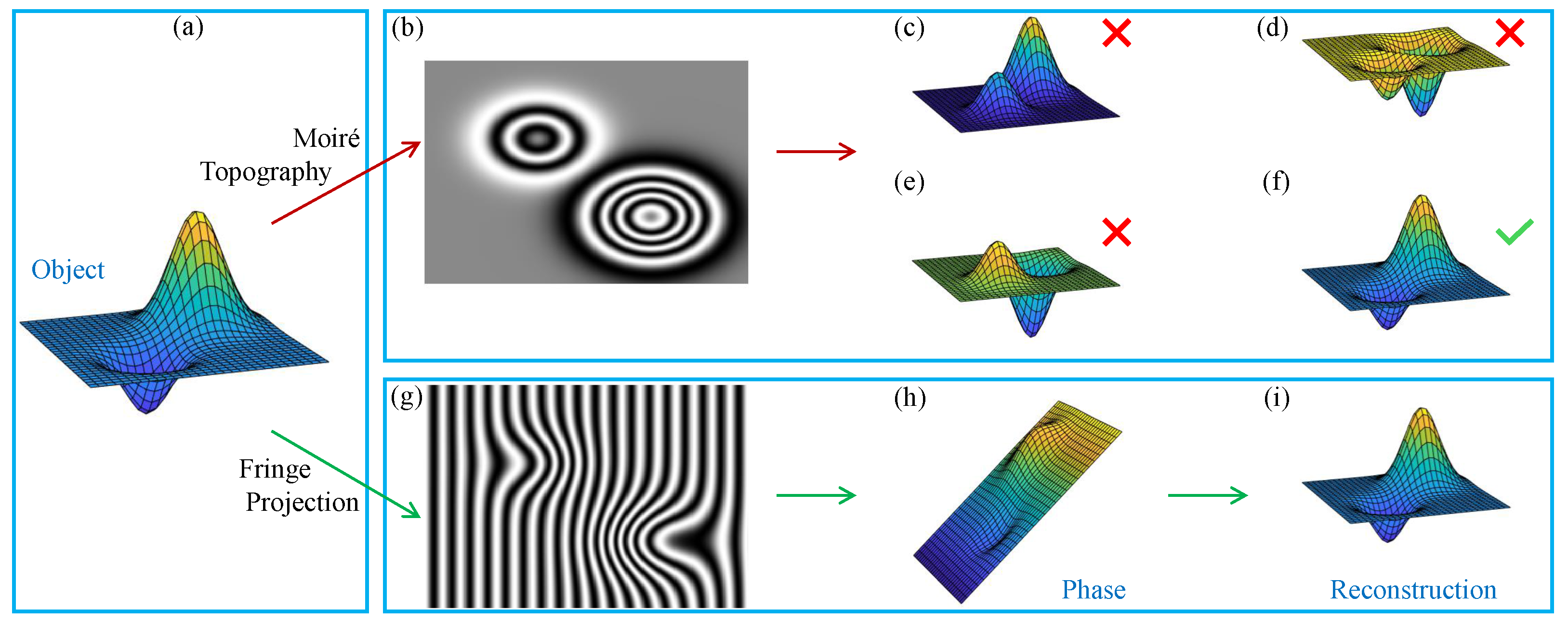
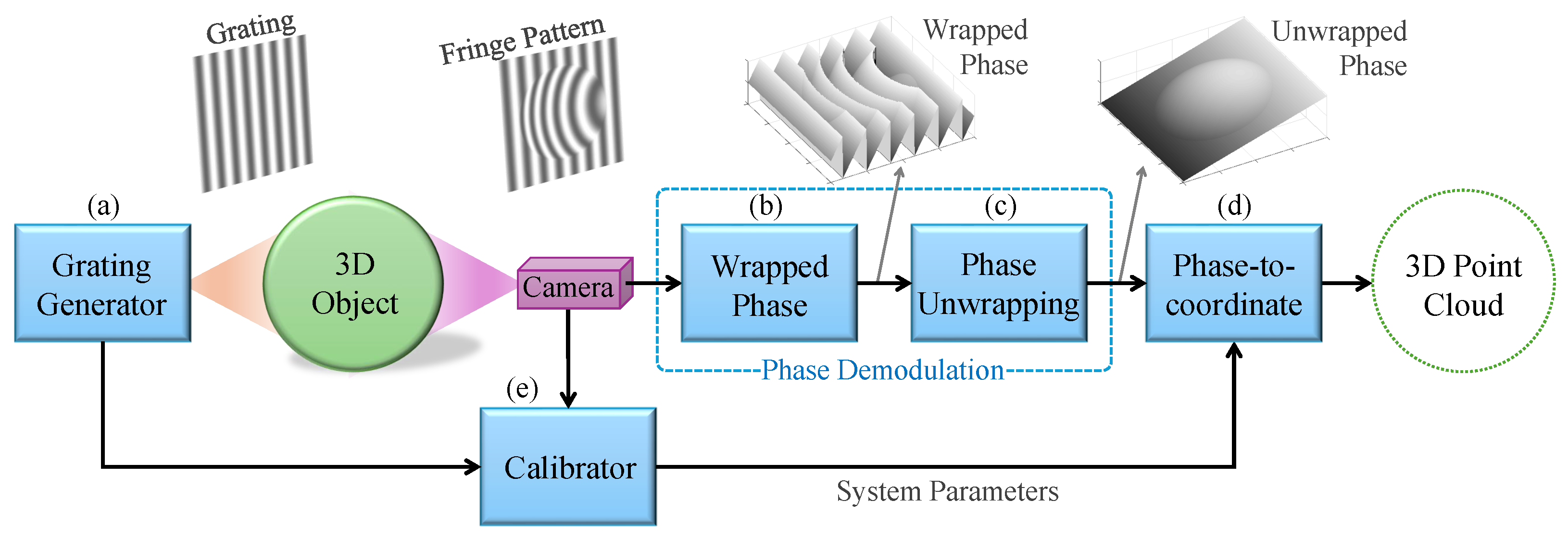

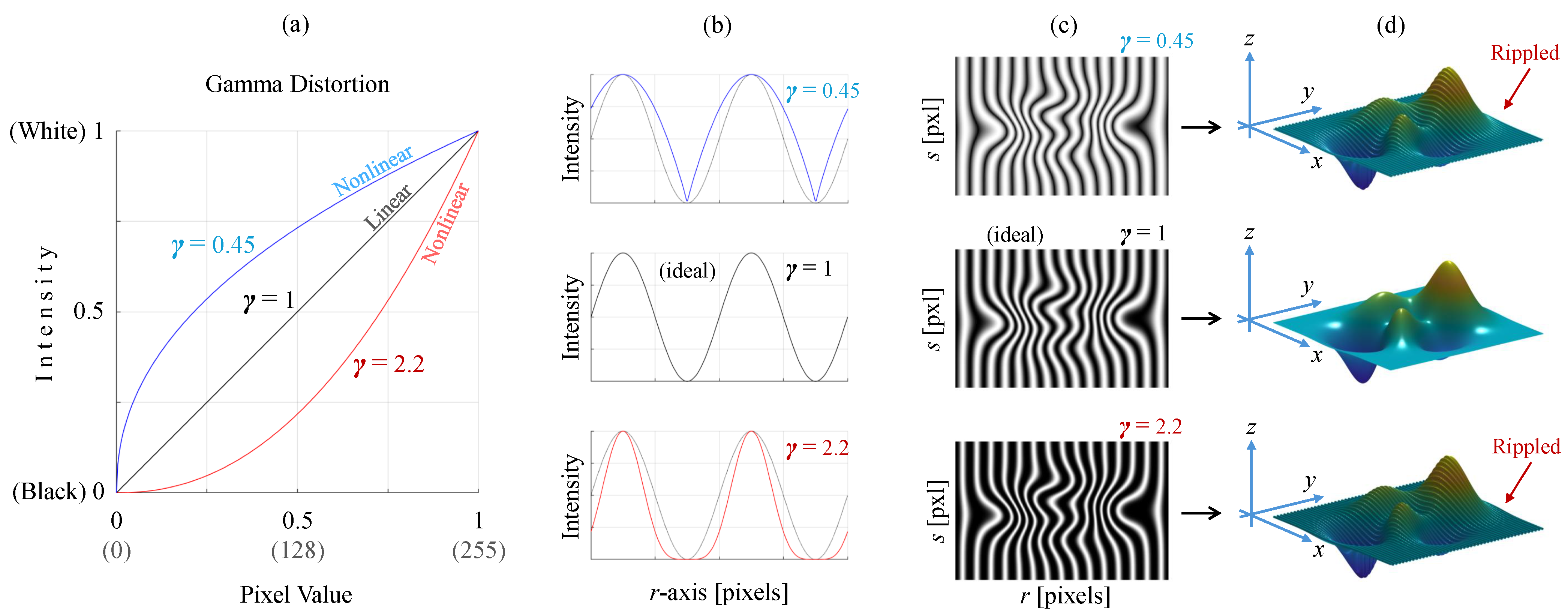
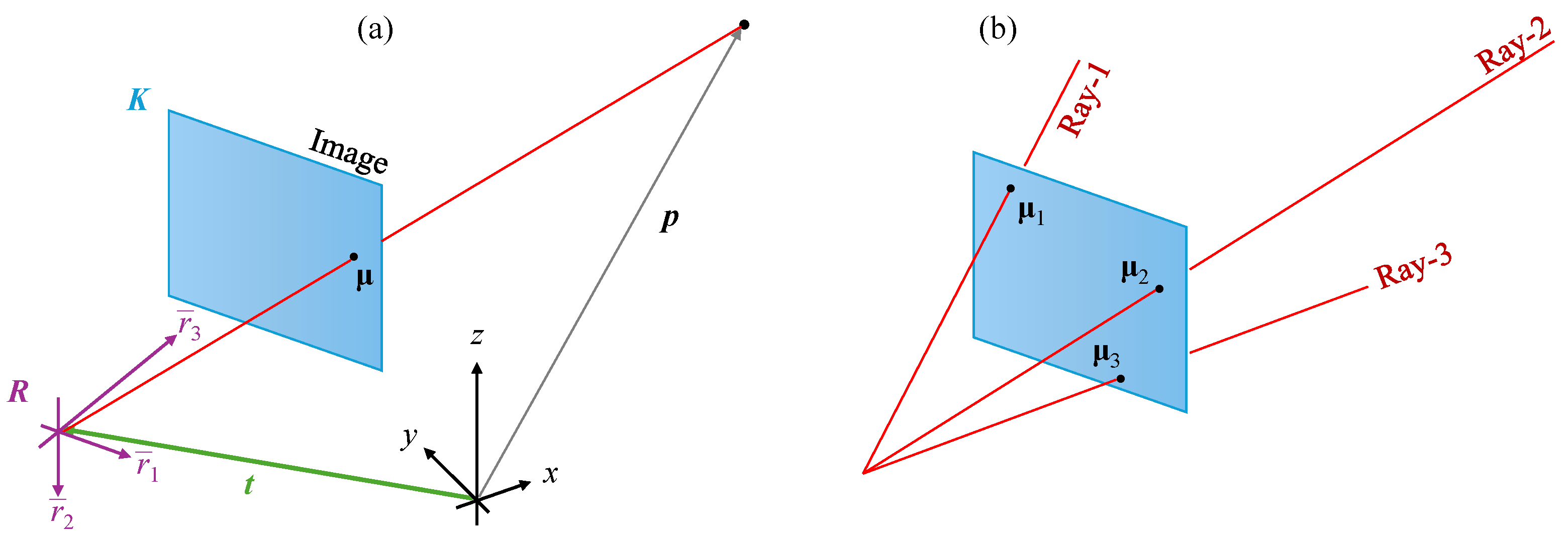
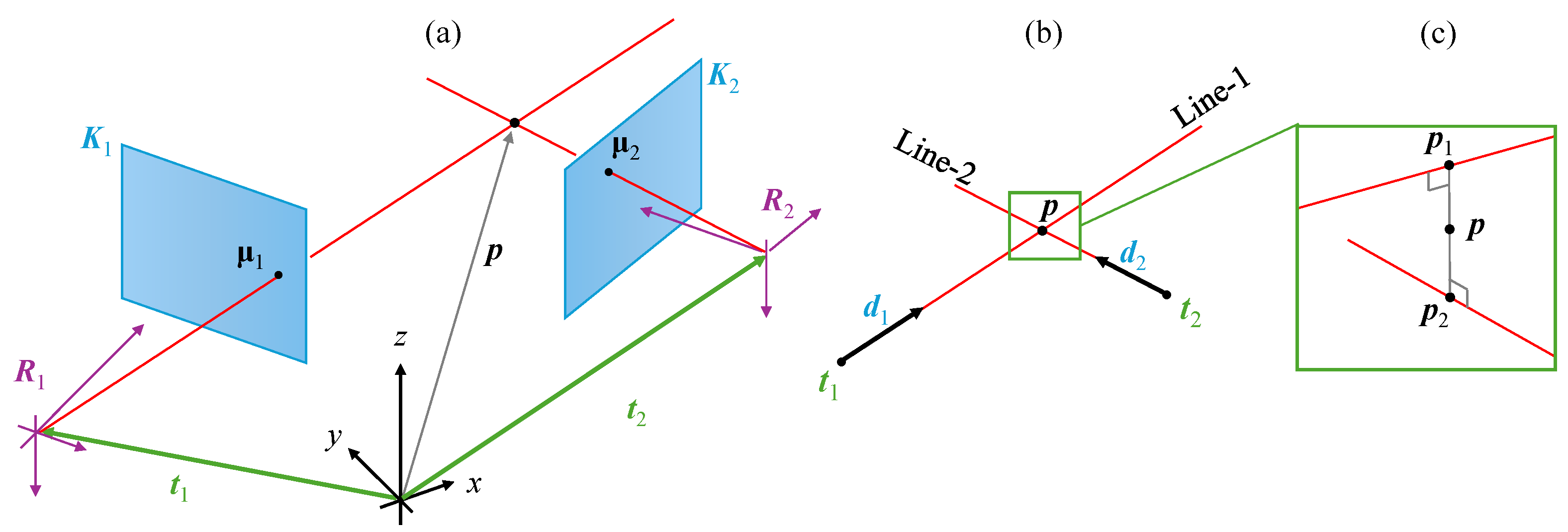

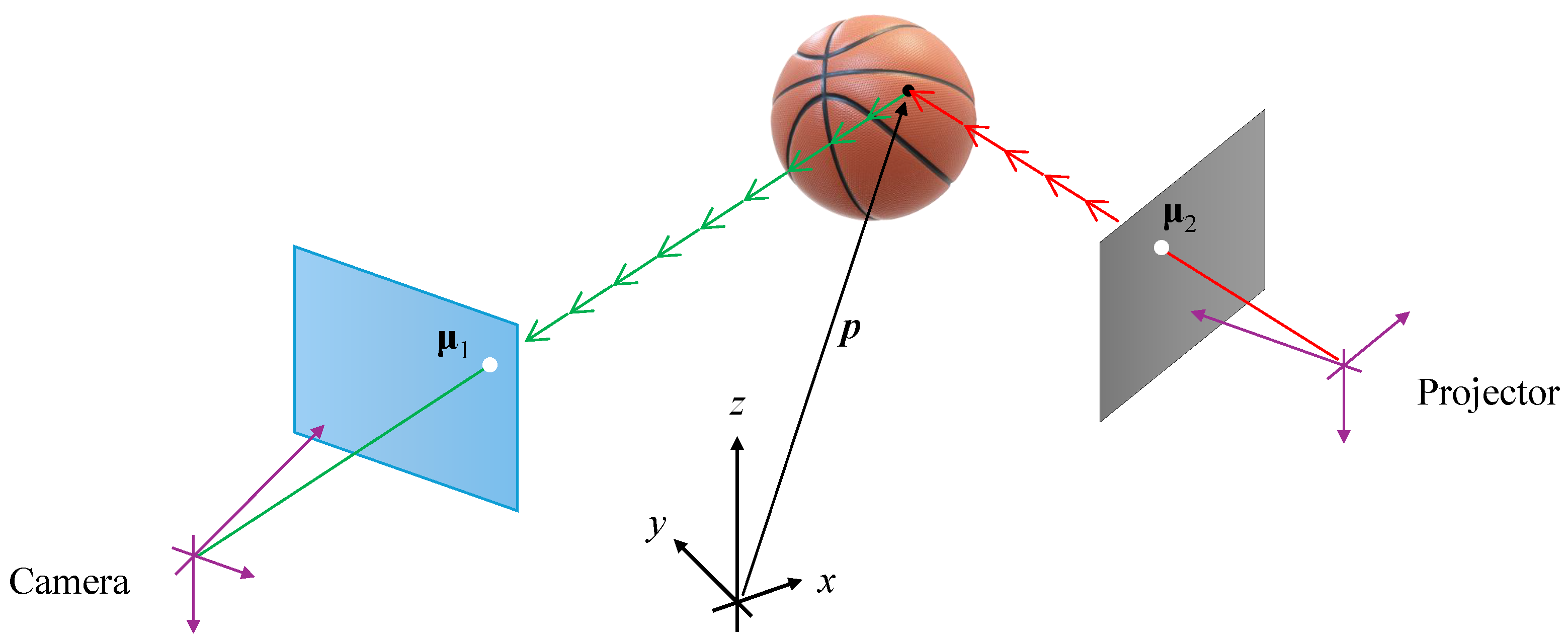
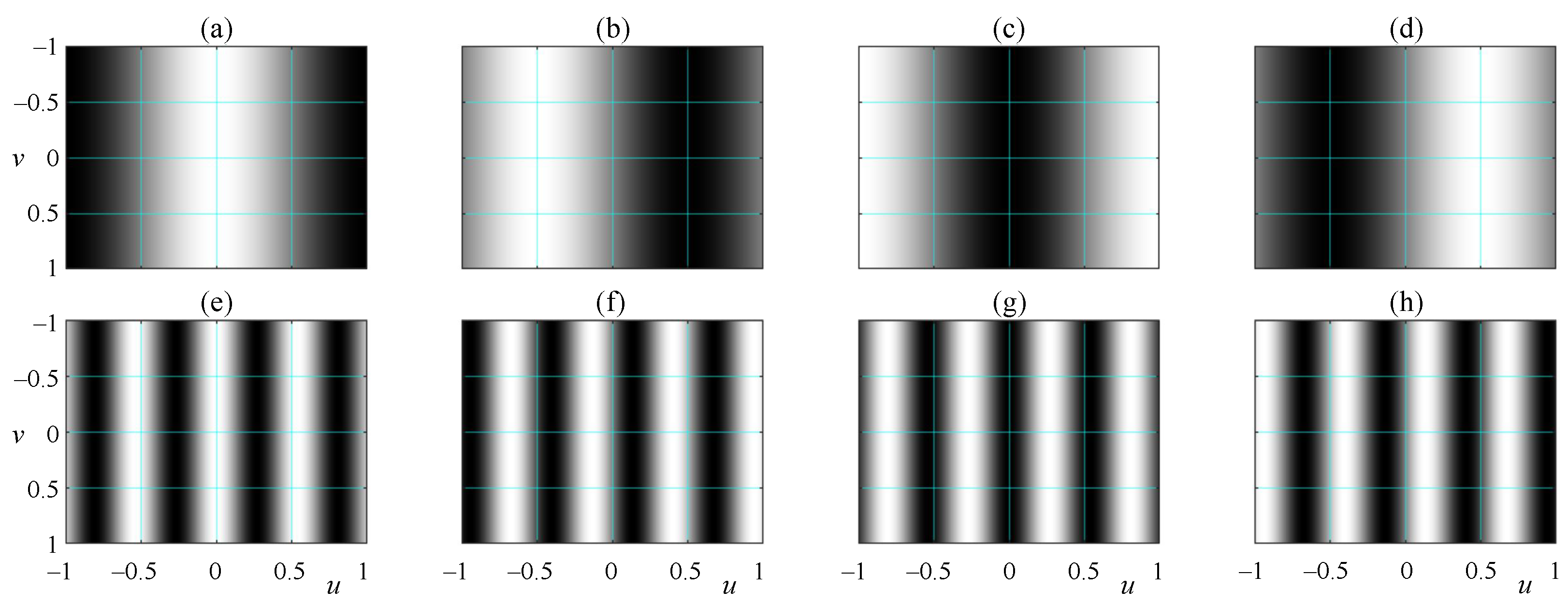
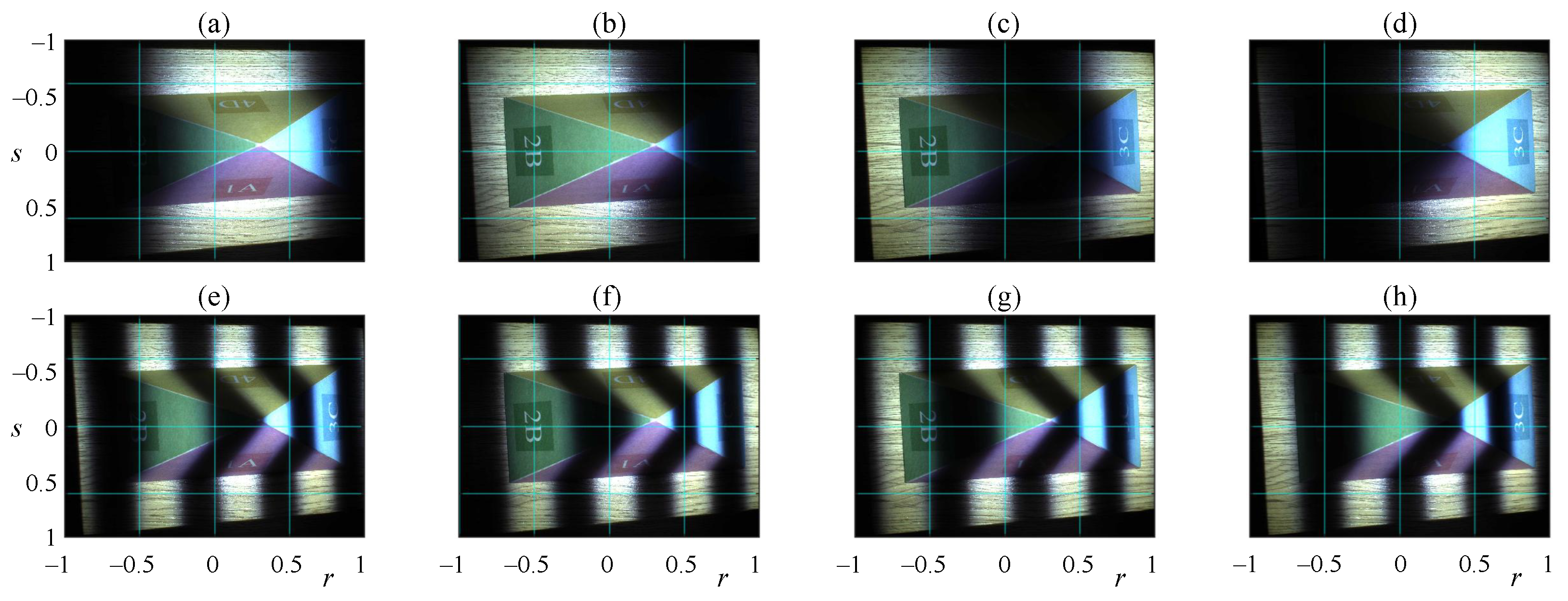


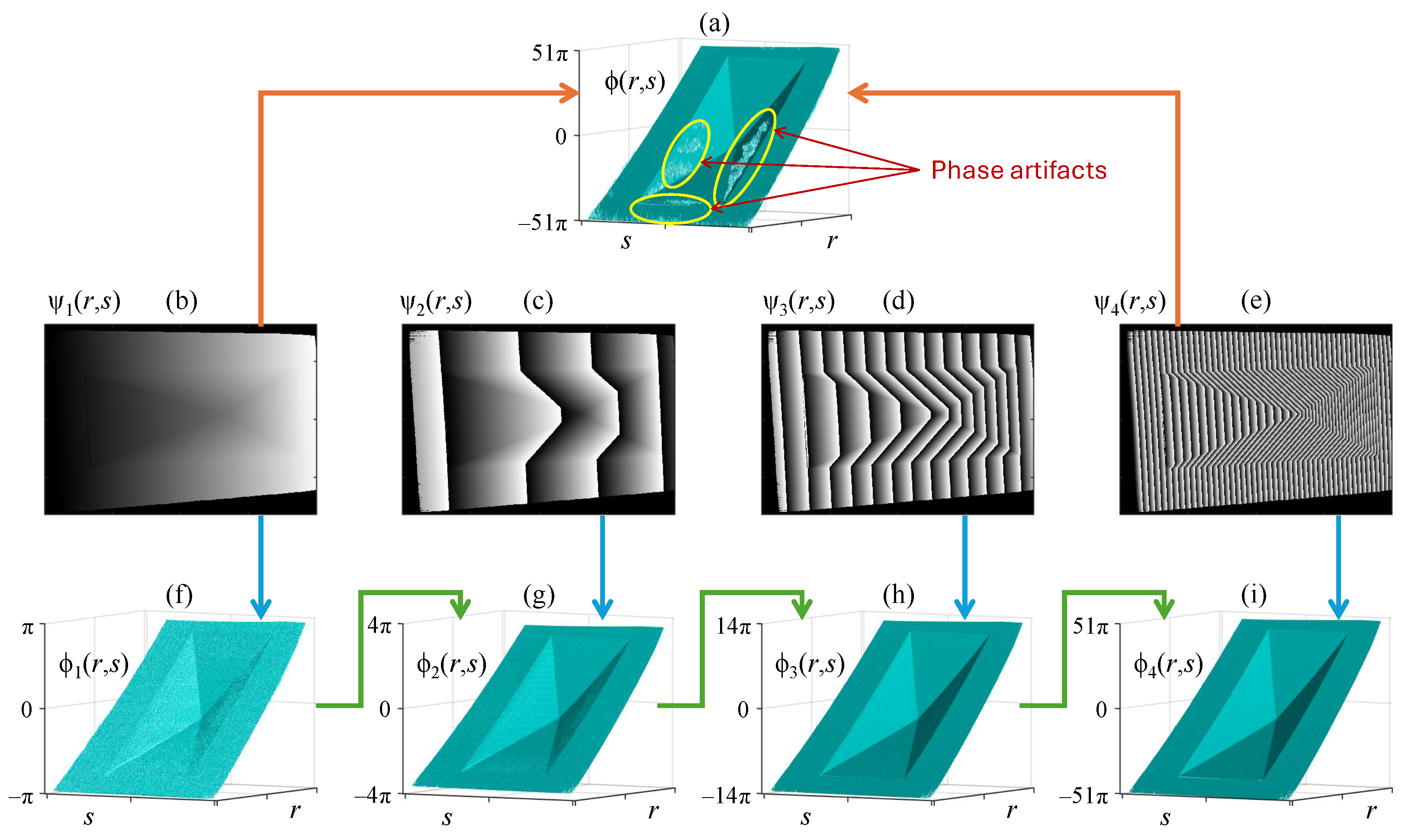
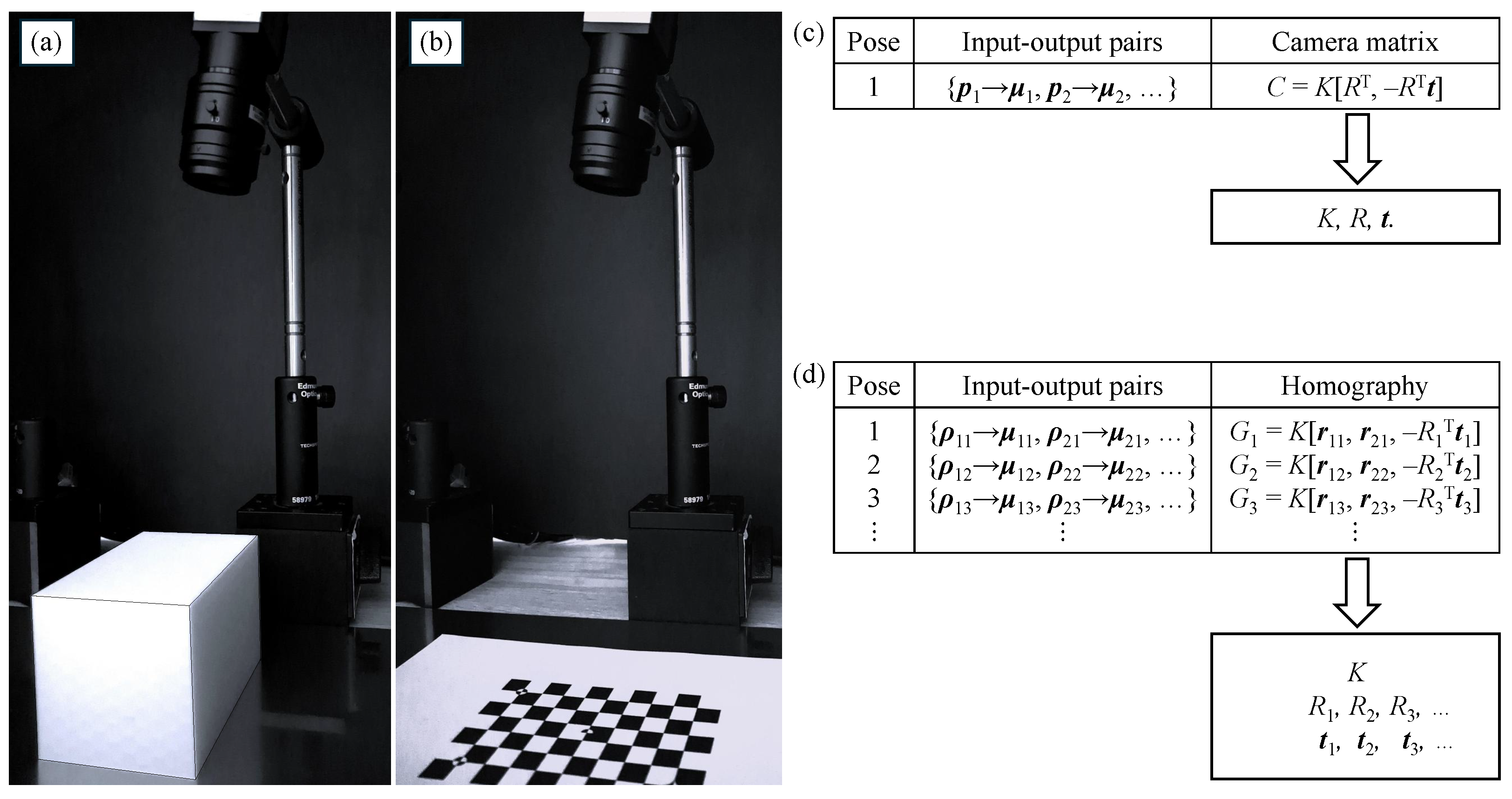
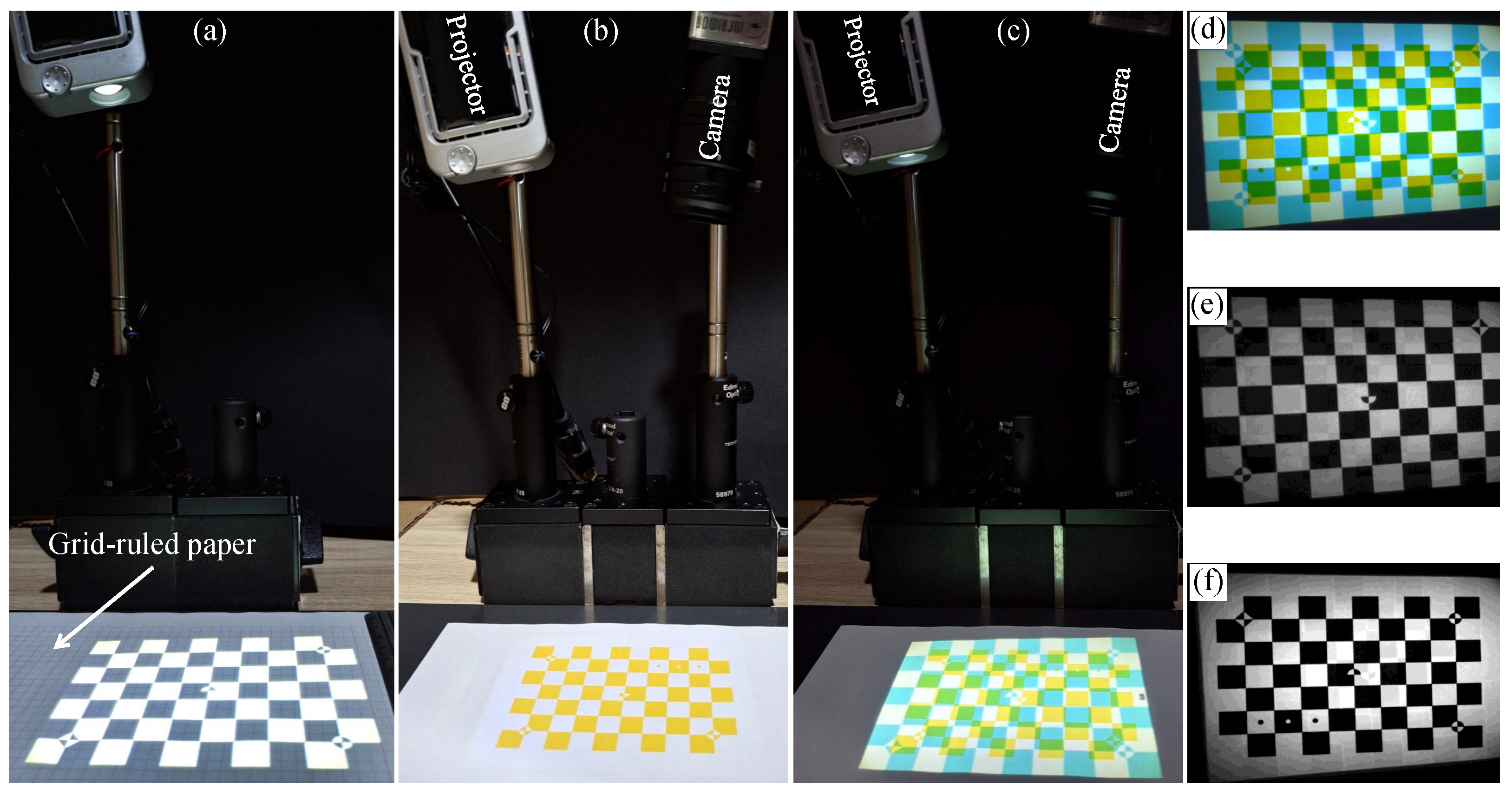
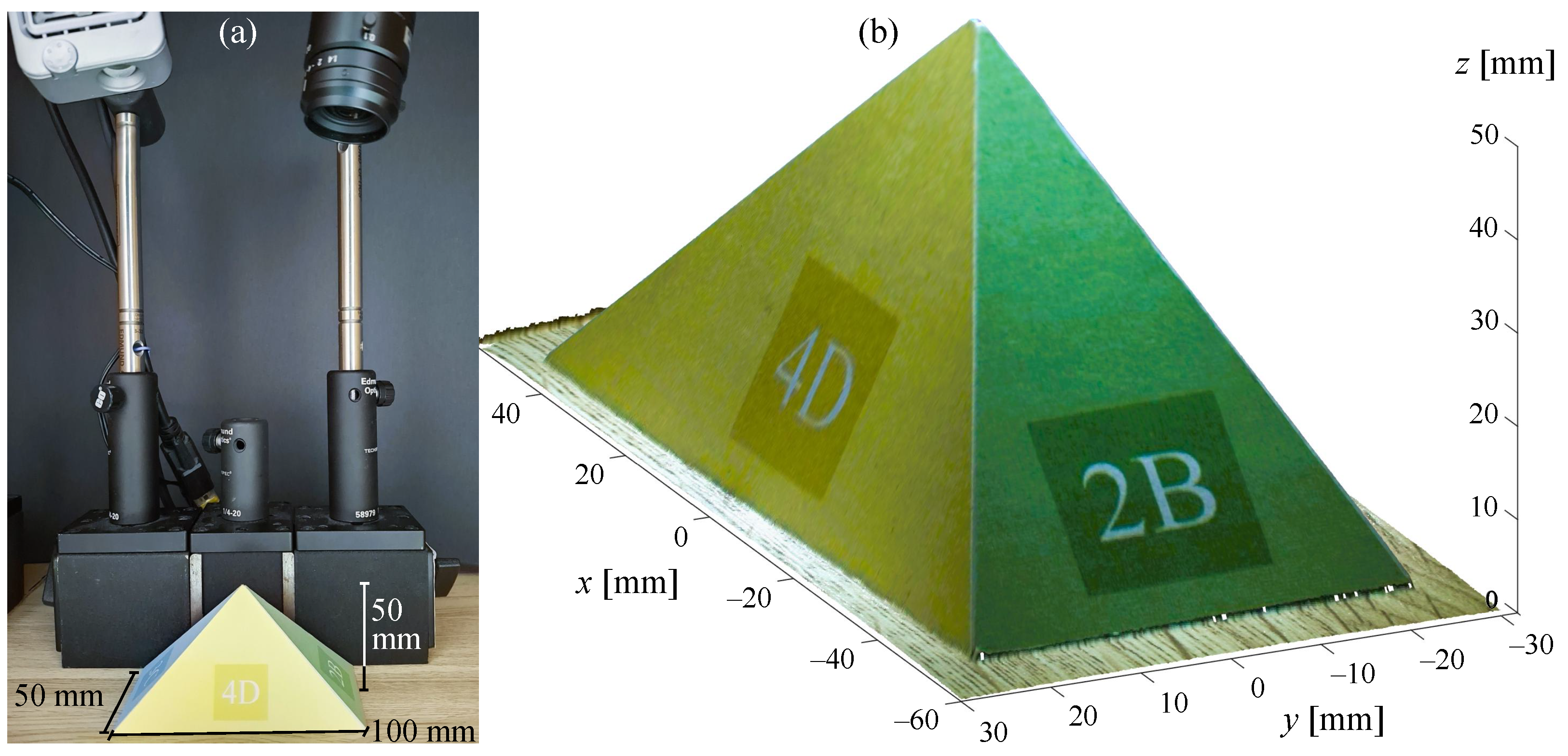
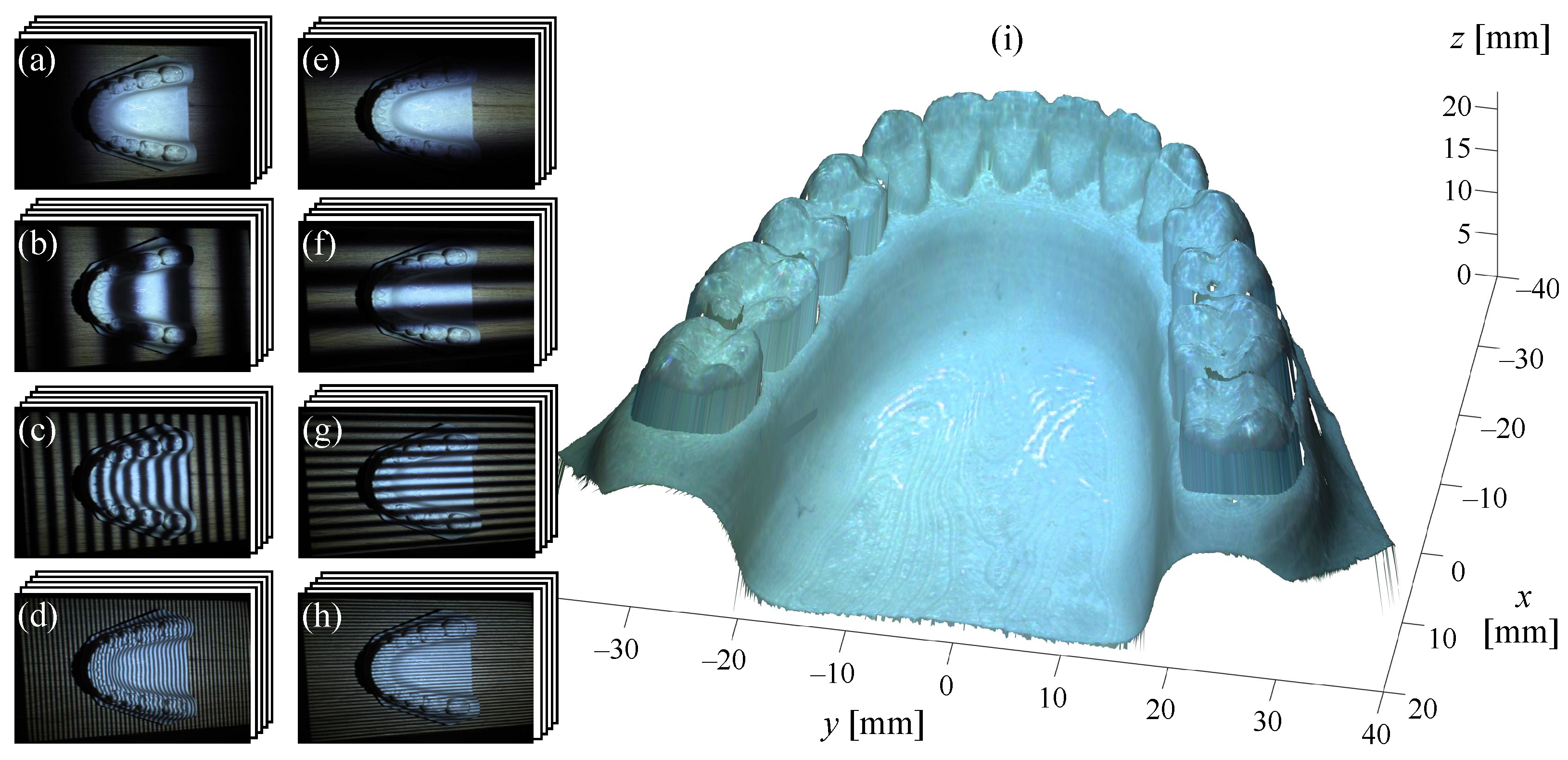
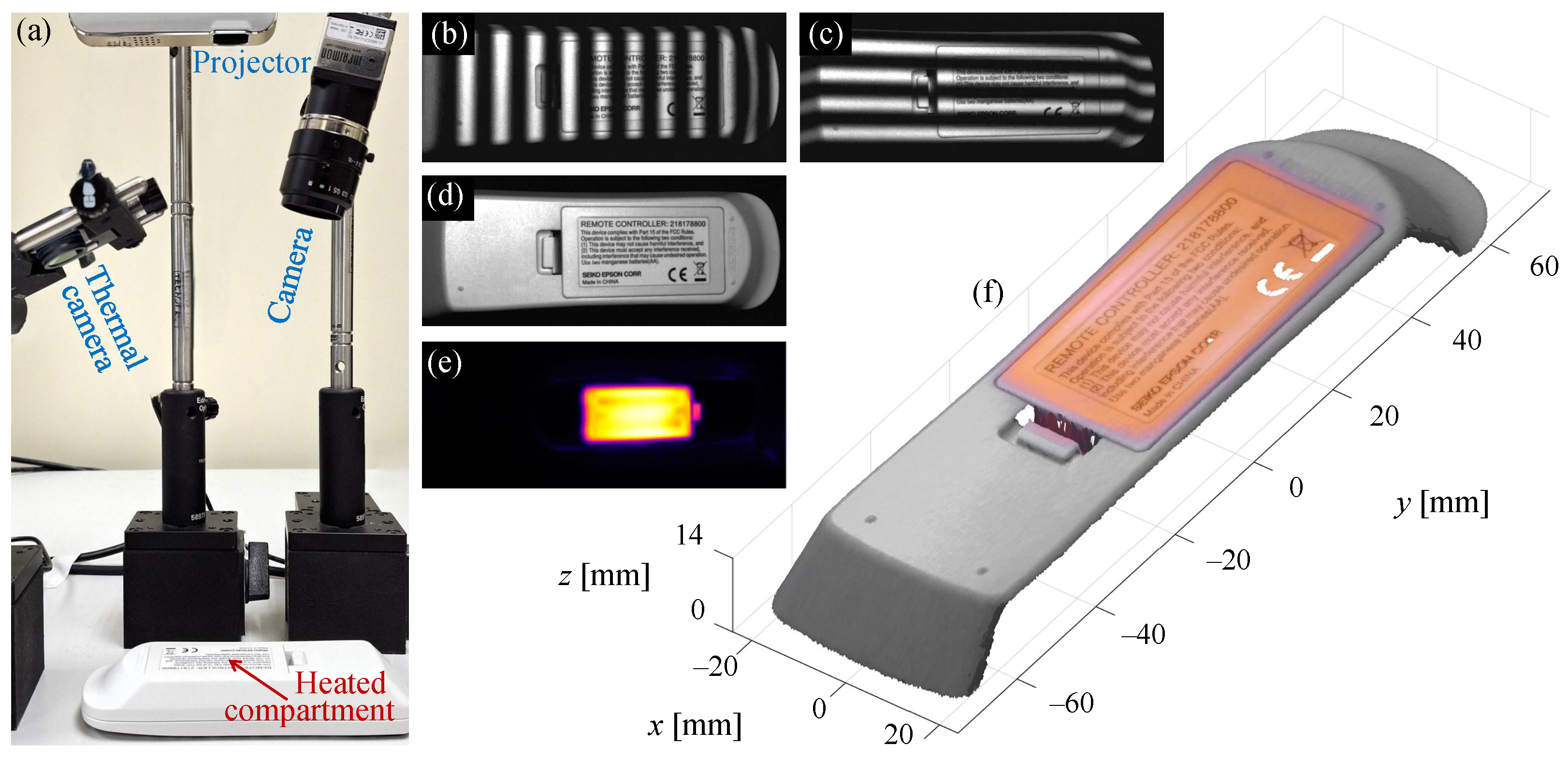
Disclaimer/Publisher’s Note: The statements, opinions and data contained in all publications are solely those of the individual author(s) and contributor(s) and not of MDPI and/or the editor(s). MDPI and/or the editor(s) disclaim responsibility for any injury to people or property resulting from any ideas, methods, instructions or products referred to in the content. |
© 2025 by the authors. Licensee MDPI, Basel, Switzerland. This article is an open access article distributed under the terms and conditions of the Creative Commons Attribution (CC BY) license (https://creativecommons.org/licenses/by/4.0/).
Share and Cite
Juarez-Salazar, R.; Esquivel-Hernandez, S.; Diaz-Ramirez, V.H. Optical Fringe Projection: A Straightforward Approach to 3D Metrology. Metrology 2025, 5, 47. https://doi.org/10.3390/metrology5030047
Juarez-Salazar R, Esquivel-Hernandez S, Diaz-Ramirez VH. Optical Fringe Projection: A Straightforward Approach to 3D Metrology. Metrology. 2025; 5(3):47. https://doi.org/10.3390/metrology5030047
Chicago/Turabian StyleJuarez-Salazar, Rigoberto, Sofia Esquivel-Hernandez, and Victor H. Diaz-Ramirez. 2025. "Optical Fringe Projection: A Straightforward Approach to 3D Metrology" Metrology 5, no. 3: 47. https://doi.org/10.3390/metrology5030047
APA StyleJuarez-Salazar, R., Esquivel-Hernandez, S., & Diaz-Ramirez, V. H. (2025). Optical Fringe Projection: A Straightforward Approach to 3D Metrology. Metrology, 5(3), 47. https://doi.org/10.3390/metrology5030047





